Crossing from India to Pakistan you immediately see the difference between the two. Sure the landscapes look the same - sunbaked plains and chaotic towns, but the Hindu temples have been replaced by mosques and unimaginably colourful trucks and buses ply the roads. So it kind of is like India, but at the same time isn't.
There was a time when India and Pakistan were one country and there was only one Punjab, but from 1947 when Pakistan gained its independence from India, there are two - one Punjab in India, and one in Pakistan. In the latter, mosques now dominate the cityscape, as back when Pakistan separated people were given the opportunity to choose the country in which they wished to stay. A massive (and bloody) migration took place as many Hindus moved to the Indian side and many Muslims moved to the Pakistani side of the new border. One of the proposed name candidates for the new born country - today's Pakistan - was Islamistan.
Thus there is a great difference between the Indian and the Pakistani Punjab, at least when it comes down to interaction between people. In India or Nepal for example, I do not remember anyone expressing their impatience or anger, because in Hinduist and Buddhist cultures it is considered embarrassing even to raise your voice. What I remember is people being positive minded and (sometimes extremely) curious.
In Pakistan, however, the first impression was that of cheerlessness and indifference. And edginess. Which is strange, because so far we had thought of Muslims as of very warm and welcoming people. Maybe it is just the distrust towards the westerners? Or maybe it is just because we have arrived fresh out of a totally different mind set and the contrast is just too big? Or is it because we are simply over heated in this climate of over +40C (+104F)?
Even the A/C power socket in our hotel room could not take the pressure:
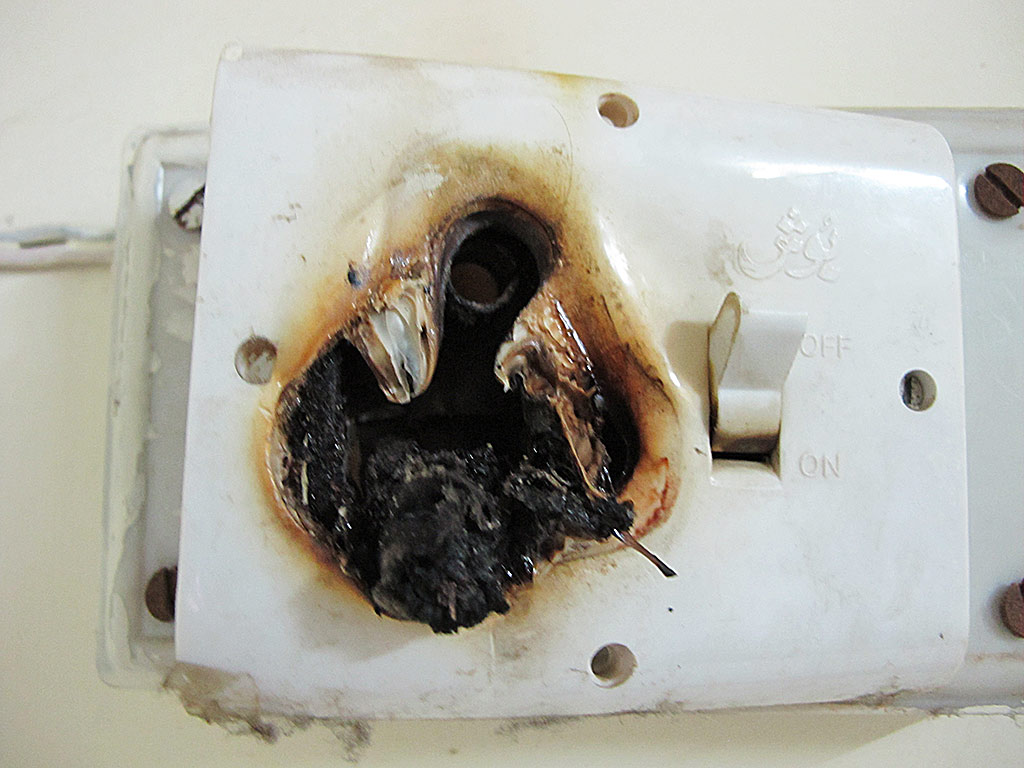
Thank God it didn't happen in the night and didn't burn down the hotel.
The people that work in the services sector are somewhat absent in anything they do, and the menus in the restaurant are only in Urdu which we fail to understand. It has been a long time since we last felt unwelcome in a strange country.
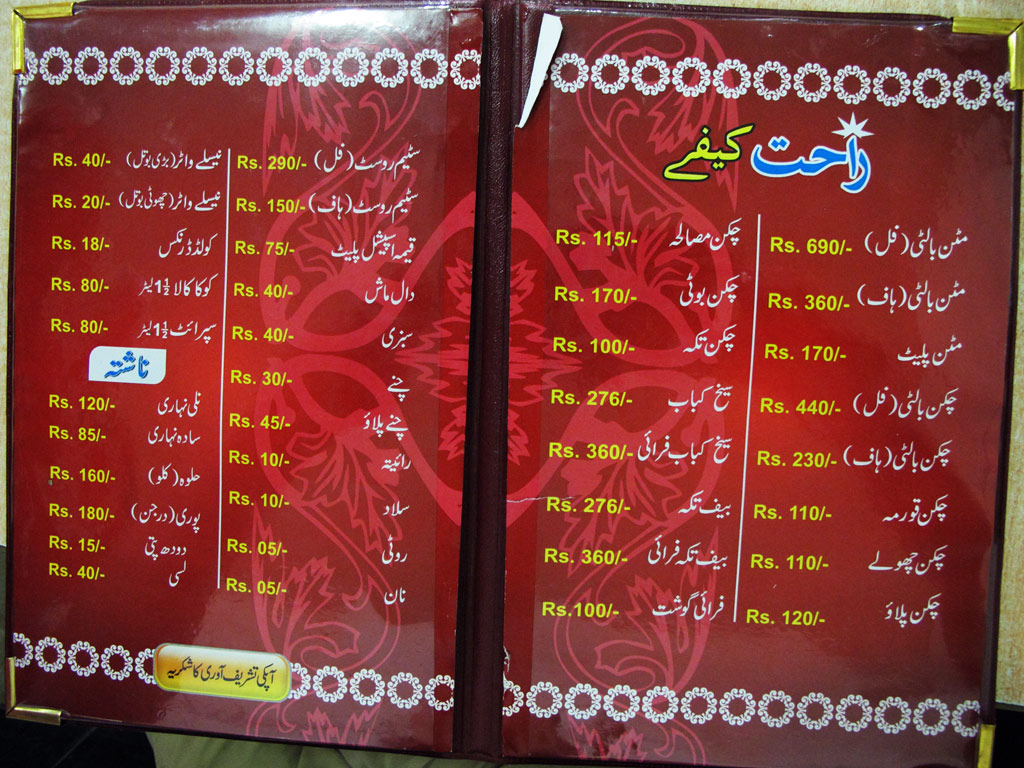
Menu in Urdu language.
In Lahore we were intending to go and have a look at Sufi (Islamic mysticism) rituals, but the meetings had been suspended as a couple of terrorists had blown themselves up at a Sufi meeting just a week ago, killing 42 and injuring 175 people! Had the Manali road been opened earlier, we just might have been one of those people.
Rather depressed, we went to try out a local dessert - falooda, which in Lahore comprises ice-cream and vermicelli. It looked nice when it was brought to table, but the waiter told us to mix it well, so that it became rather an interesting looking soup. I guess our desserts would look weird to Pakistanis, too. In any case it tasted good and we would definitely go for another if we find one.
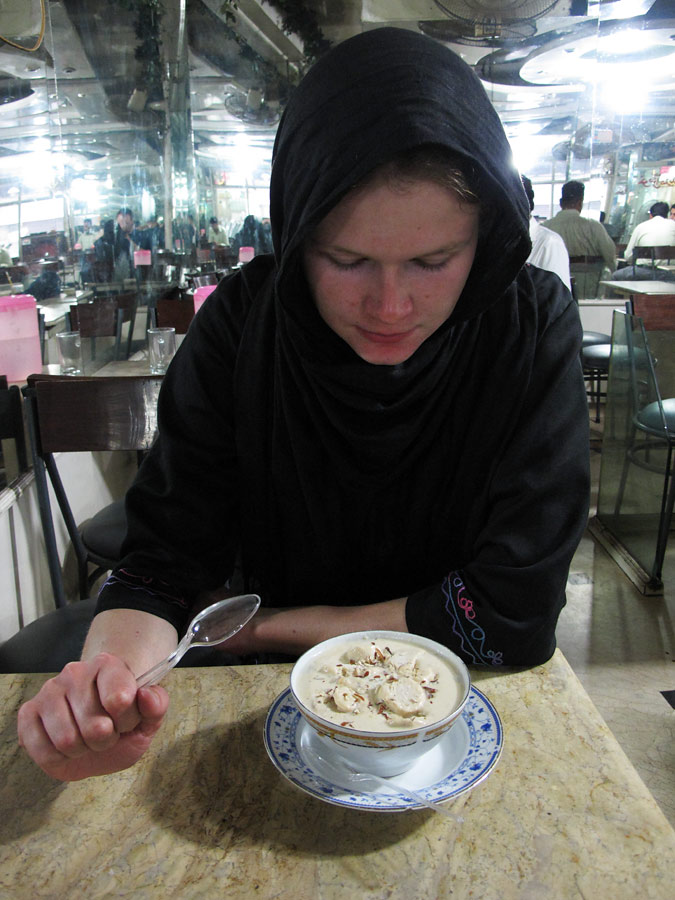
Kariina and falooda.
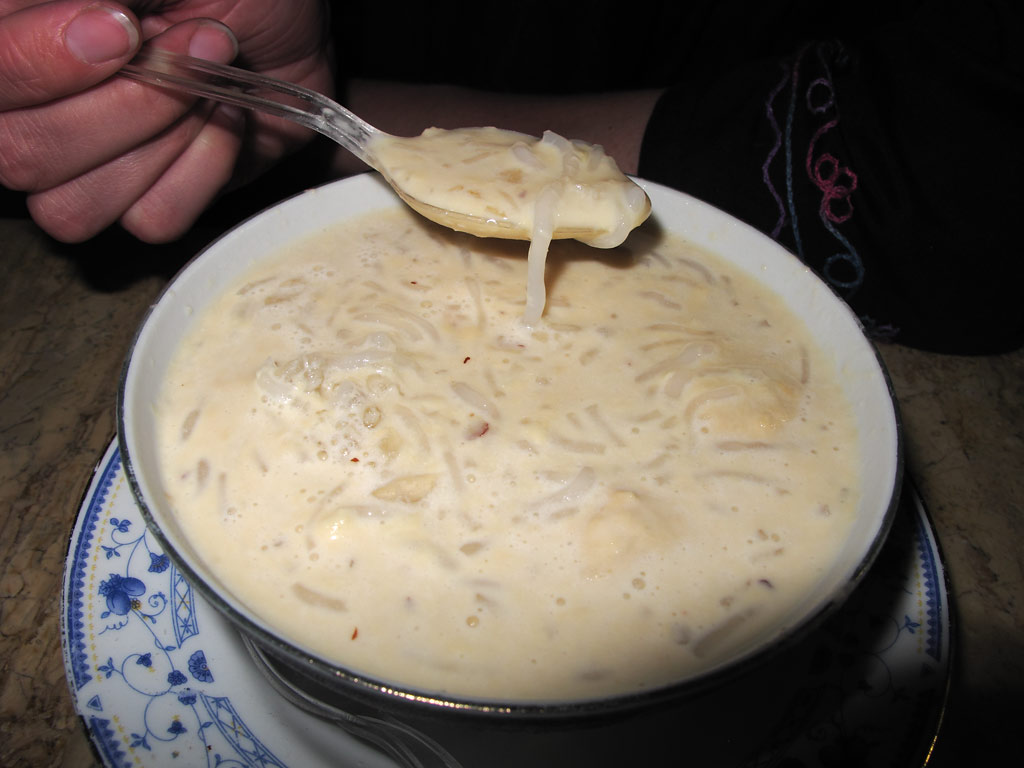
Also worth mentioning on the culinary side - there is a chain in Rawalpindi, the sister city of Islamabad, that has the best ice cream milk shakes that we've ever tasted so far. Very recommended!
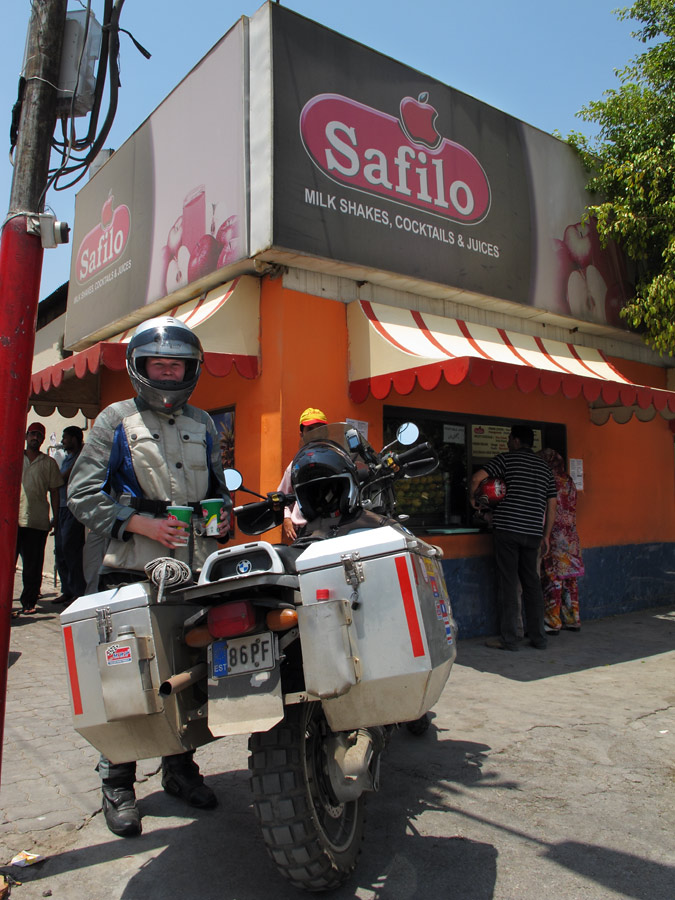
This small place in Rawalpindi serves the tastiest milk shakes!
Some more moments from our first days in Pakistan:
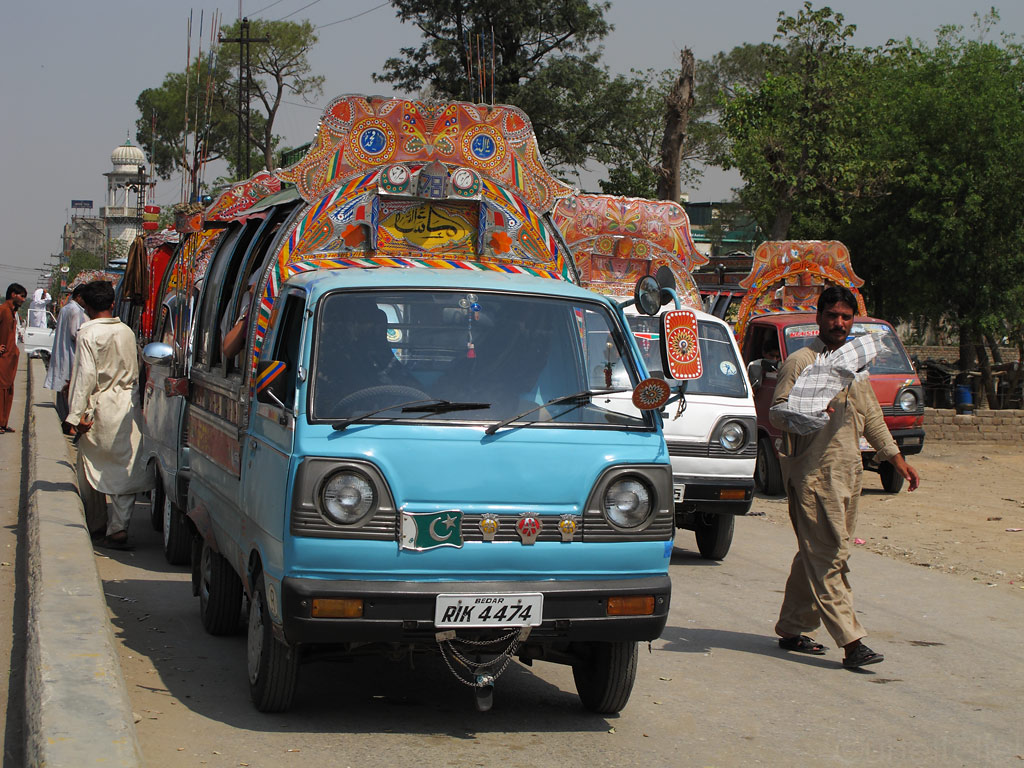
Colourful minibuses with 2-stroke single cylinder engines!
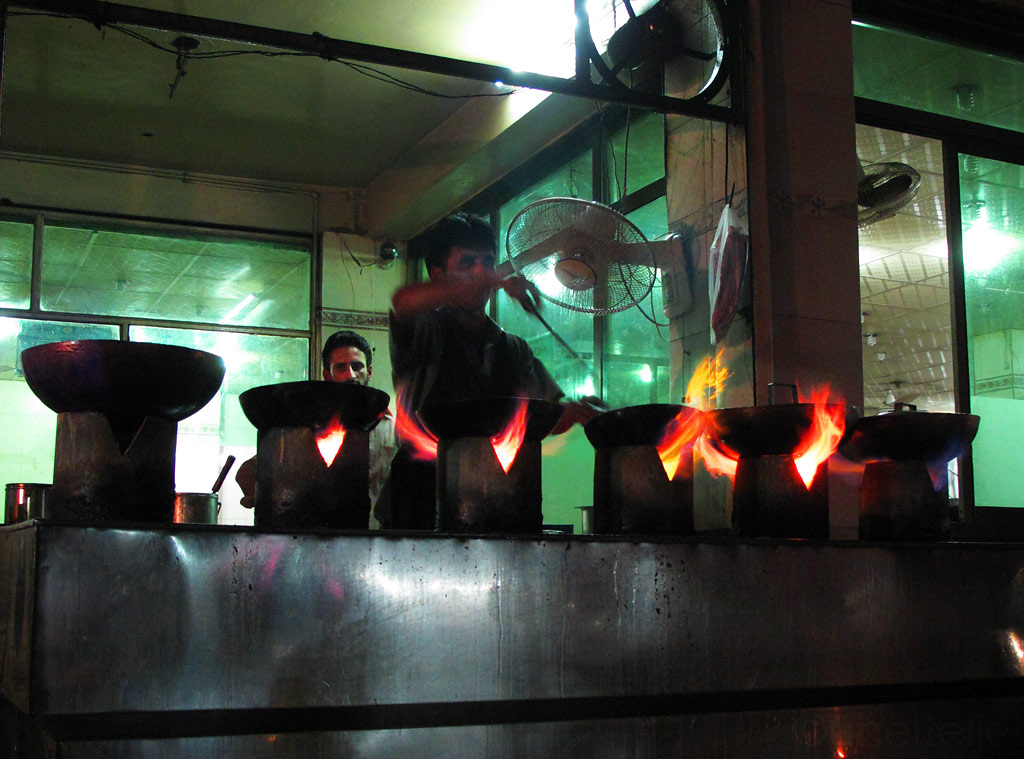
Pakistanis prepare their evening meals.
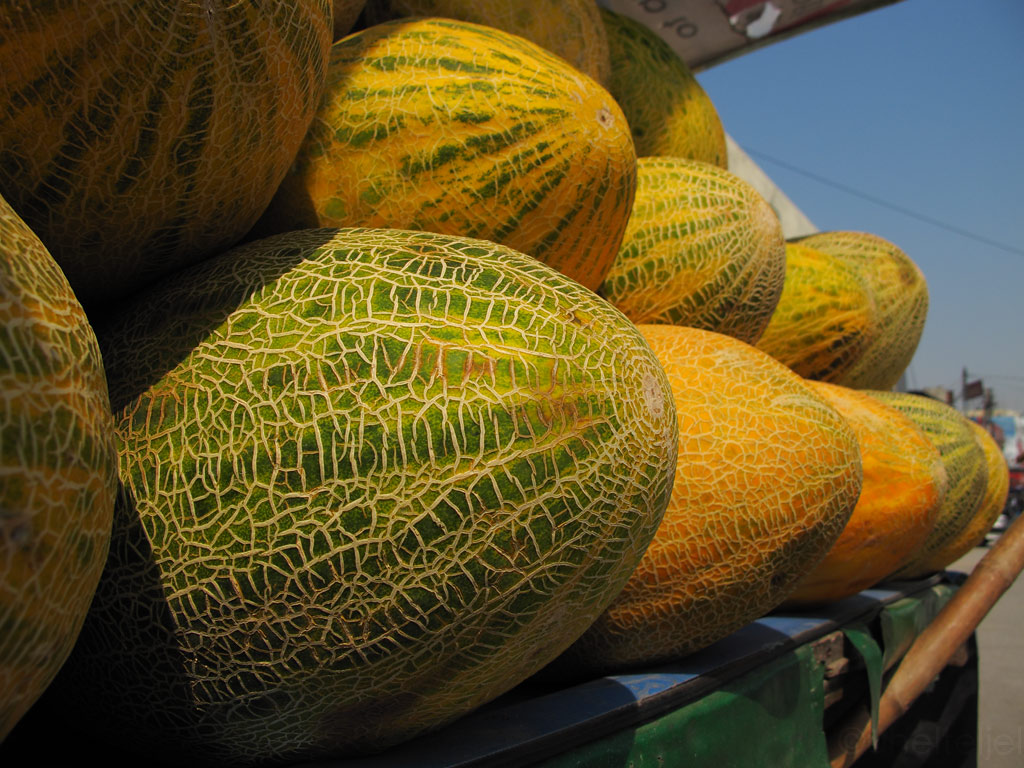
Melons for sale - bought one and they are tasty indeed!
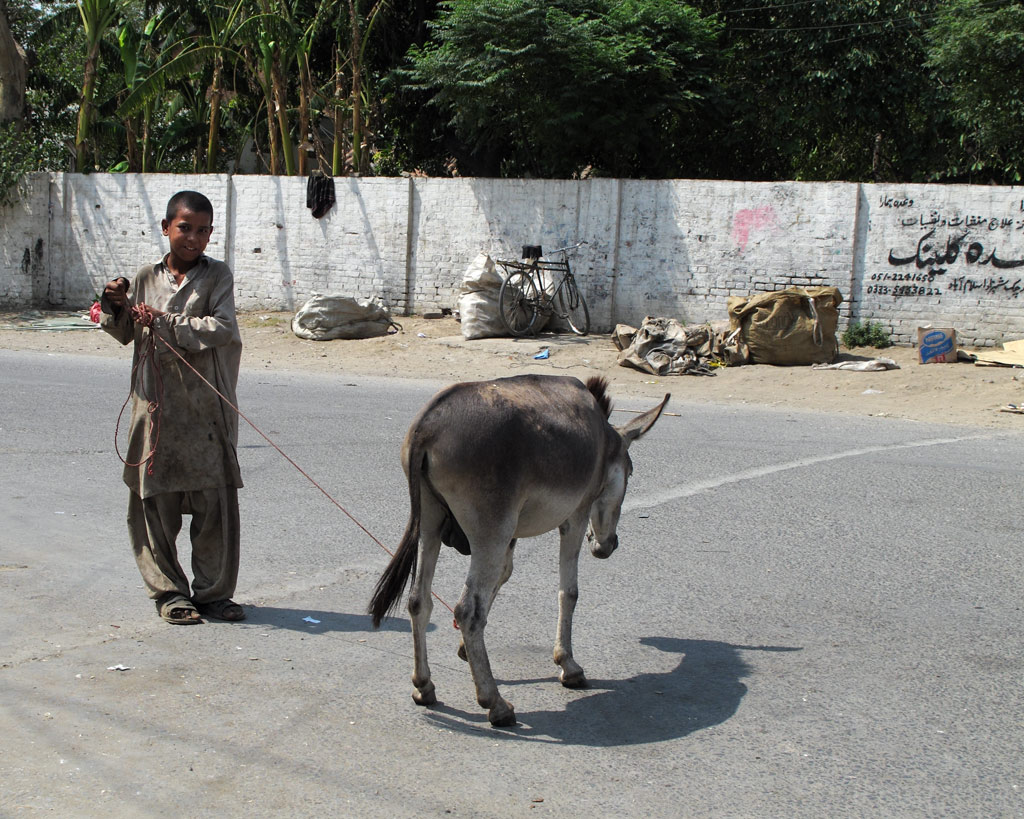
Boy with a donkey.
By the way, the constuction of Islamabad only started in 1961, so it absolutely lacks any historic ambience. The blocks are numbered and the streets are straight, but the traffic is not flowing freely as there are barricaded police check posts stationed right in the middle of the road. It might look like a garden city, a civilised place to live, but it is not meant for people without their own means of transport. It has a kind of sterile feel to it.
There are not many tourist attractions in the capital of Pakistan. One of the very few is the Shah Faisal mosque, largely sponsored by king Faisal of Saudi Arabia. It was completed in 1986 and ity can hold up to 100 000 people. According to some rumours, the CIA asked to inspect its four 88-metre minarets suspecting that these might be missiles in disguise.
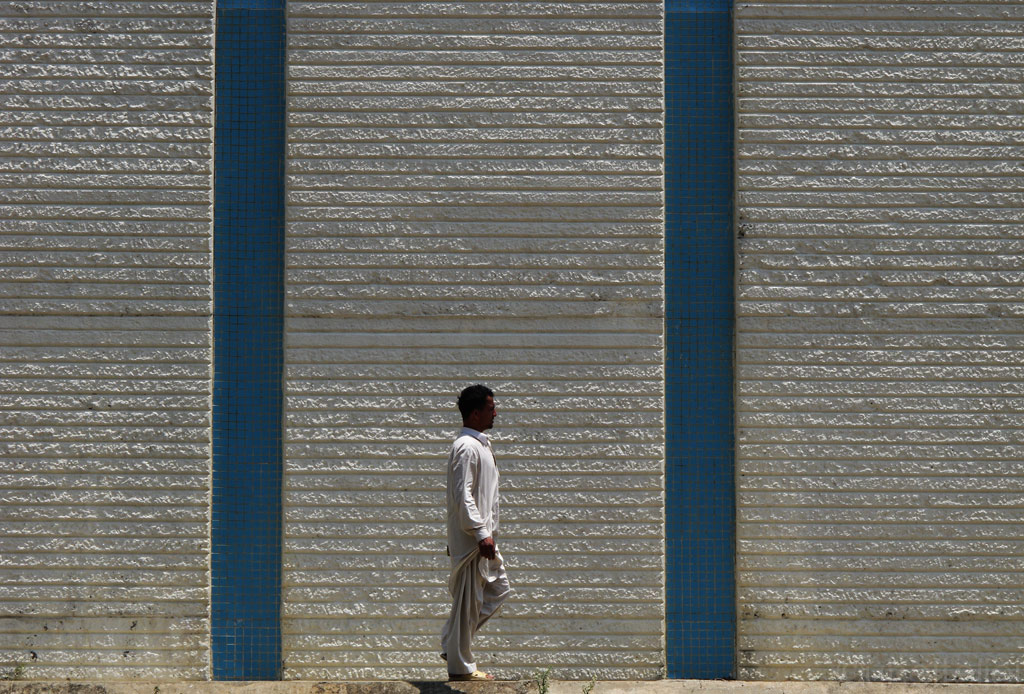
A muslim returning from prayers, beneath the Shah Faisal mosque.
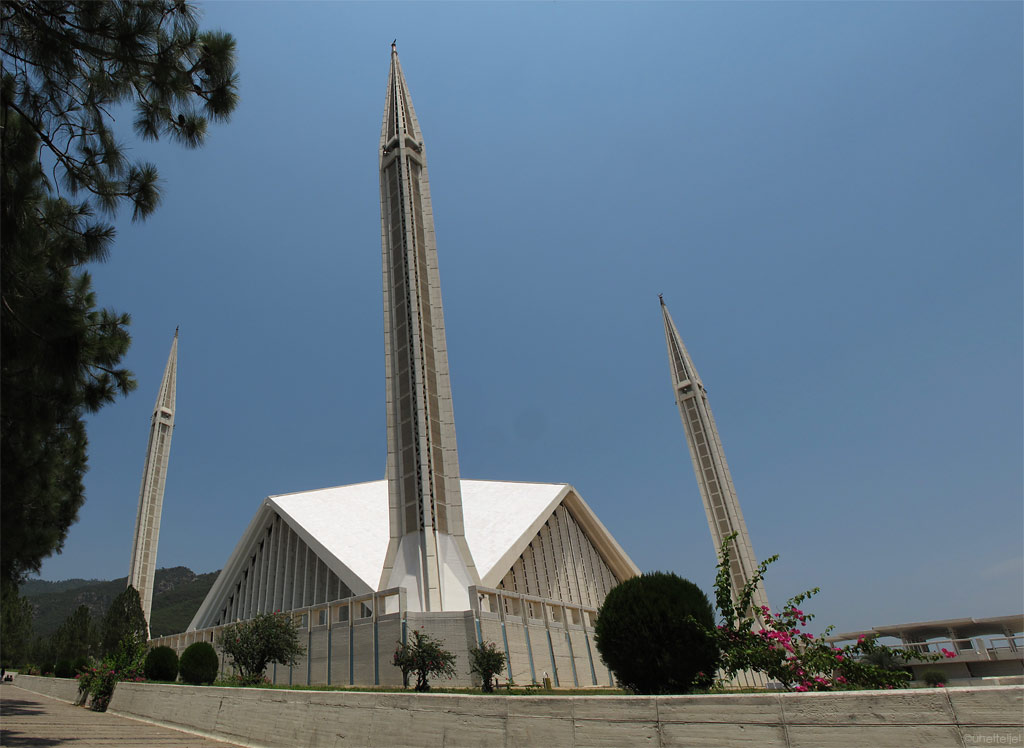
Shah Faisal with its rocketing minarets. Mosque is modelled on a desert tent and can hold up to 100 000 muslims.
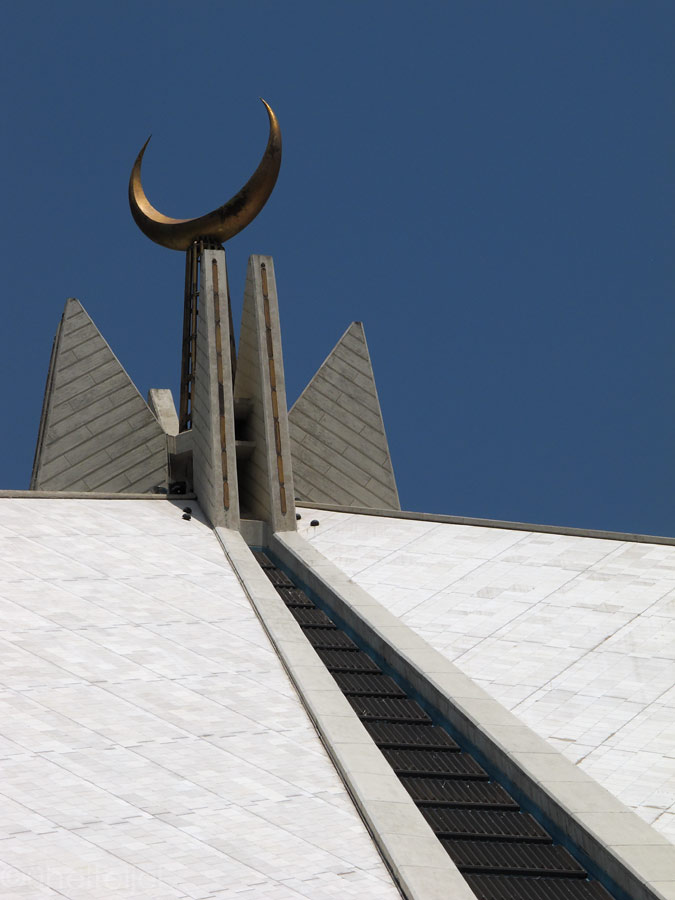
Mosque's top with its crescent.

Minaret in full length - see the man below to scale it up. No wonder CIA blamed them hiding ballistic missles in them.
From Islamabad we headed north to see the famous Karakoram Highway (KKH) - another wonder of the world, as the Pakistanis themselves think of it. Construction of this important link road between China and Pakistan began in 1959, and during 20 years that it took to be completed, almost 900 construction workers lost their lives due to falls and landslides. It spans some 1300 kilometers and is host to plenty of cultural heritage (it retraces parts of the ancient Silk Road) and views of some of the highest mountains of the world, such as 8126 metre (26 660 ft) high Nanga Parbat, for example.
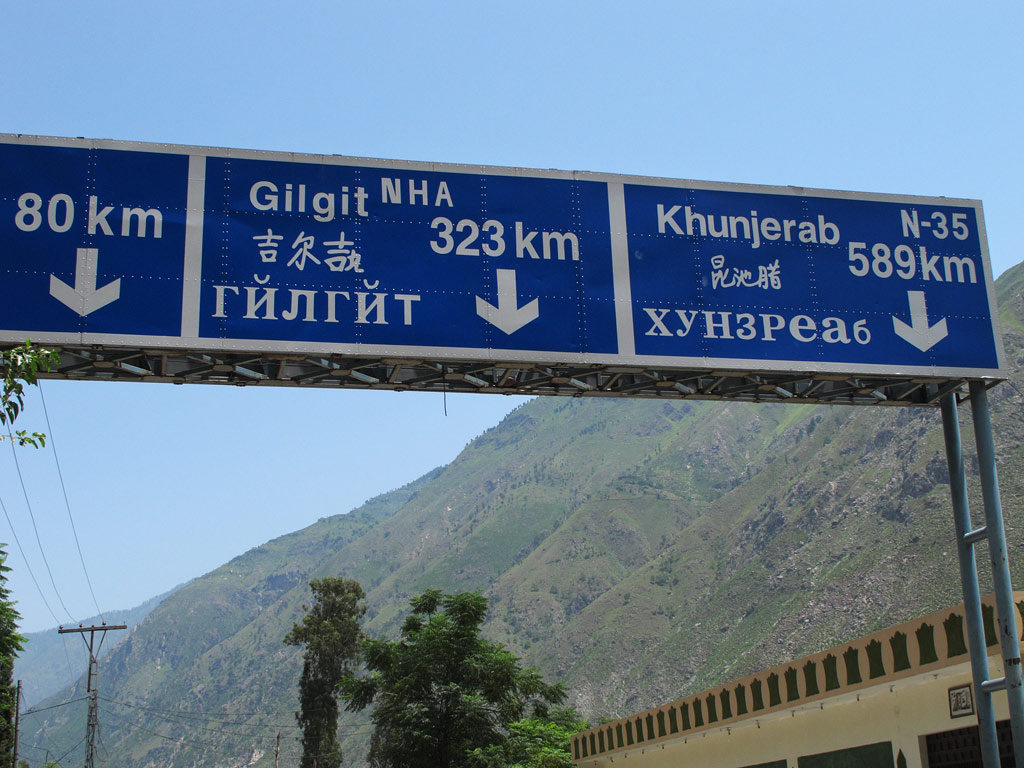
Road sign in (a bit faulty) Russian - some Tadzhik trucks (used to) pass by KKH.
The start of the road from Abbottabad was pretty tense as there was loads of traffic. Interesting how Pakistan and India are so similar. Here, just like in India, the main rule in traffic is that anyone can make any manoeuvre at any time without any indication of such intention, and generally, "the might is the right". Once again, a minibus driver was attempting a right turn to the gas station across the road without looking, crashing into us from the left side. This time the impact caused the bike to fall over to the right side, and us to fall off the bike.
Lucky there was no one coming from the opposite direction, otherwise it would have ended quite sadly. As we stood up we could not detect much damage to ourselves except for some pain in my knee. But the bike is a different story. The left pannier was completely bent from the direct hit, the tank was once again dented and the windscreen altogether with the dashboard had been broken off from the right side due to the fall. A later inspection also revealed that both front and rear subframe were bent.
In just a couple of minutes a crowd gathered. Sure, nobody spoke any English, all the less the guy to blame who just stood there blank faced as Kariina was leading her monologue on her feelings towards him and Pakistani drivers in general. She might have spoken in Estonian instead of English, it would not have provoked any reaction.
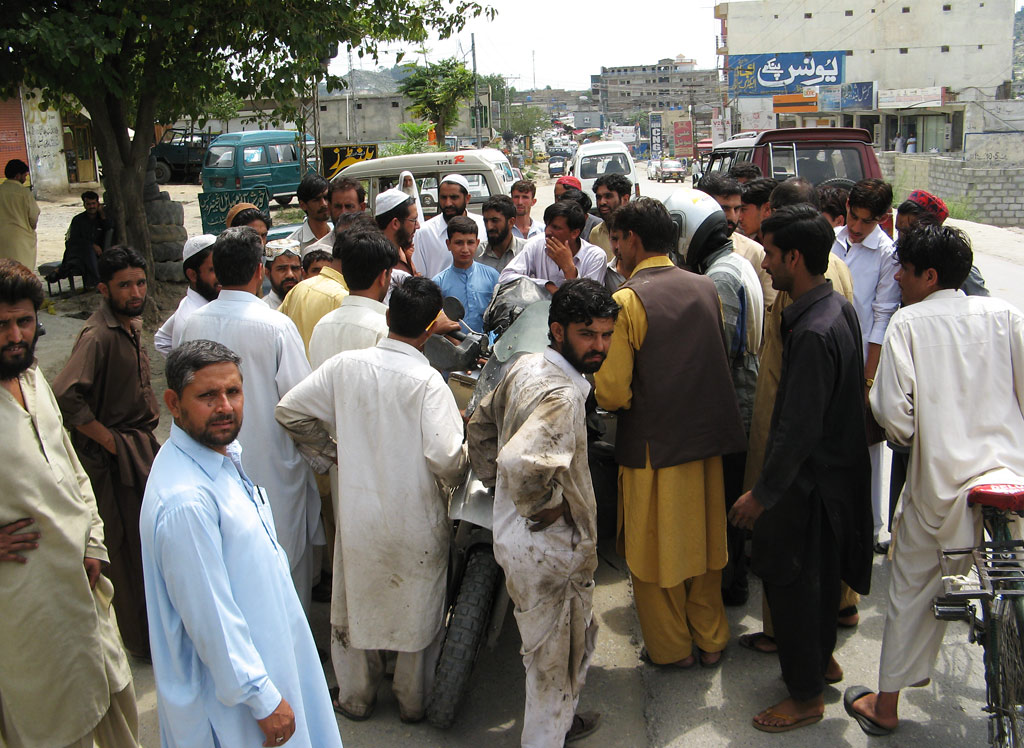
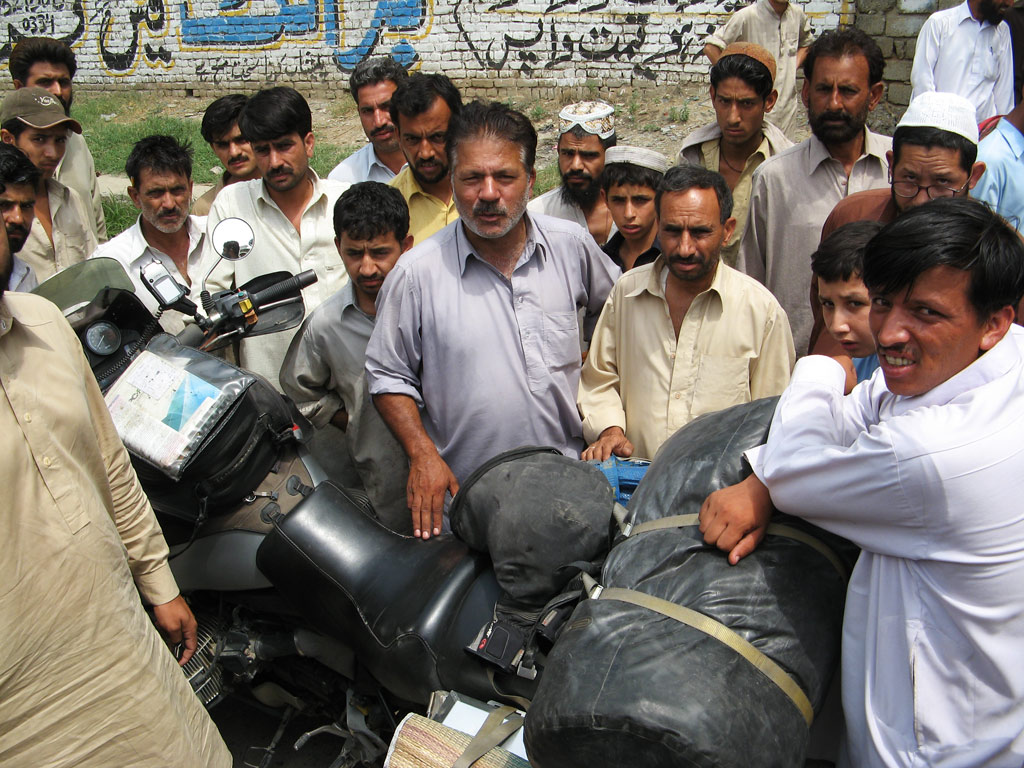
Gathering crowds - find the muslim with glasses that tries to hide from the photo - that's the selfish twat who almost killed us!
With the help from a local student we found a workshop where the pannier was hammered into a more or less regular shape. Clearly it is just a temporary solution as the lid only closes more or less, and there are some holes in it that need the hard-to-find aluminium welding - the only place they say is in Rawalpindi (like in India - amazingly ironic for a country that has nuclear capability!?). To put it simply, the pannier now is far from being waterproof.
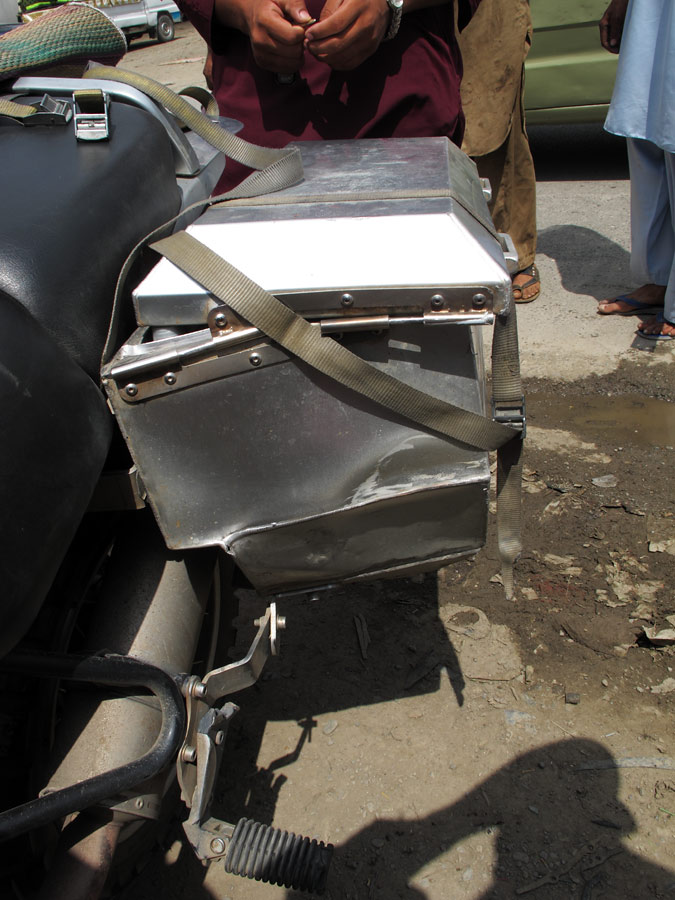
Left box took the direct hit this time (while from that force we flipped over and landed on to the other side, the other box had just scratches)
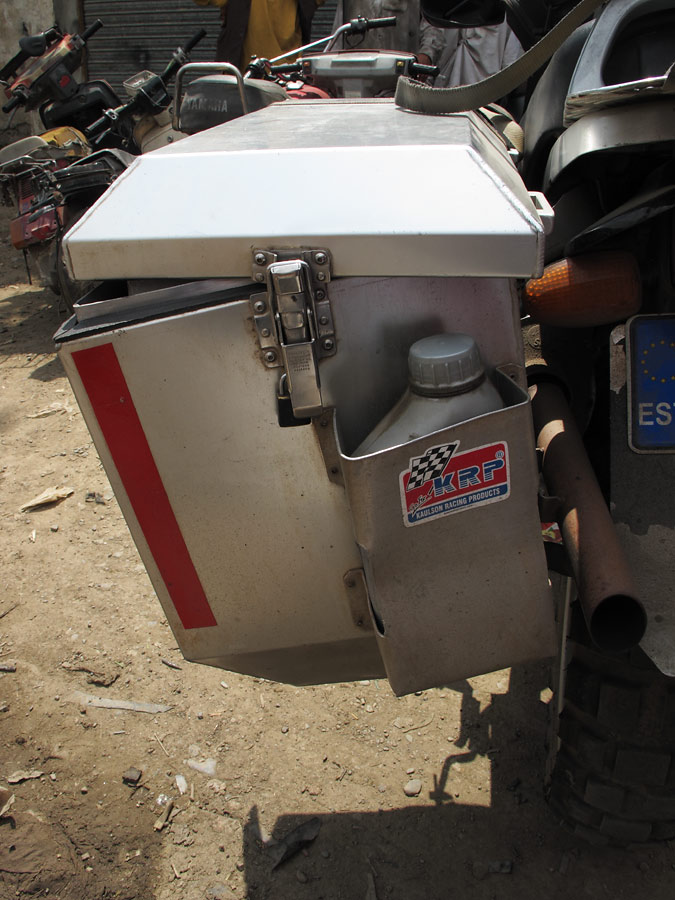
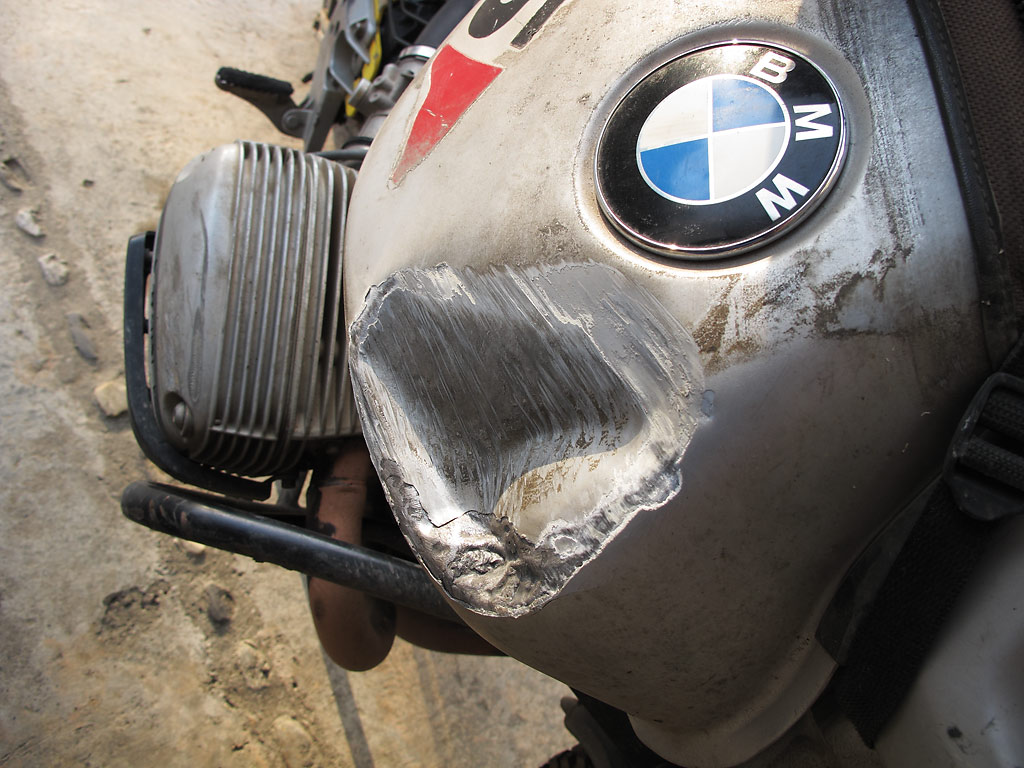
Tank, after bike landing on it.
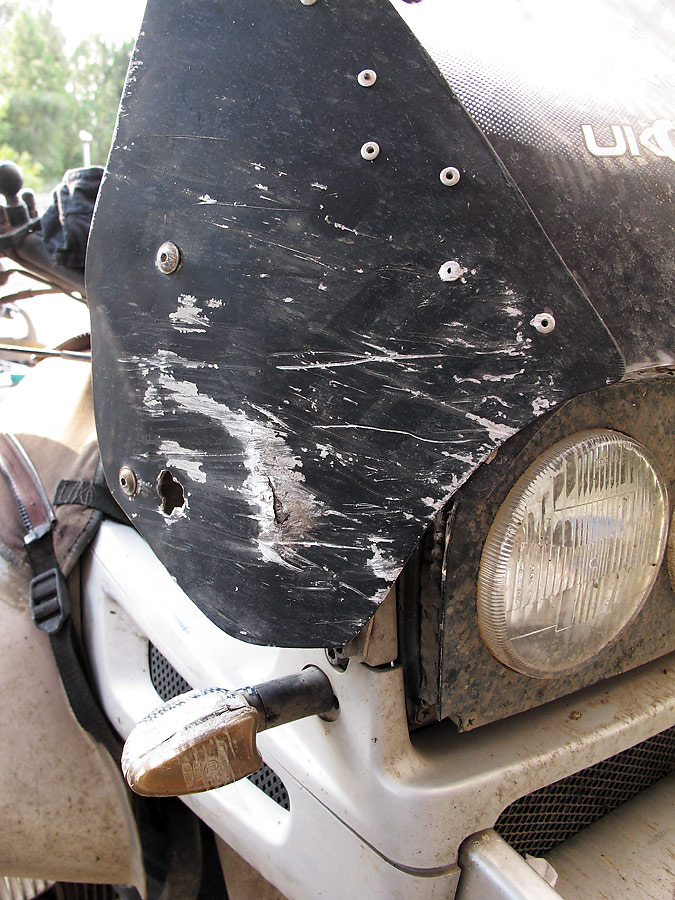
Windscreen - good thing it's already riveted with aluminium plate from the last crash in Australia.
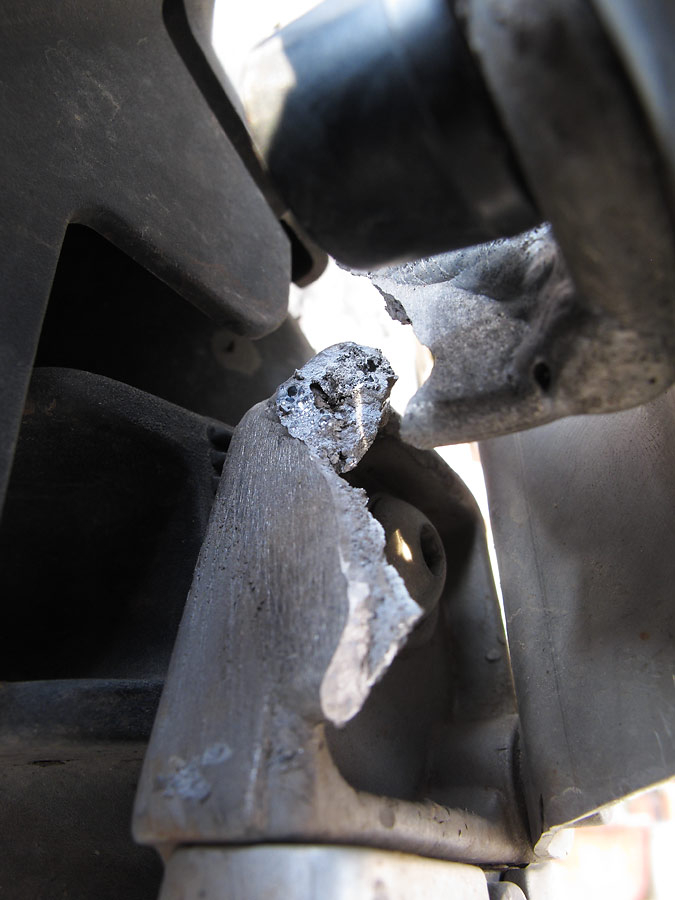
But the mount is still ripped off from the impact and also front frame is bent.
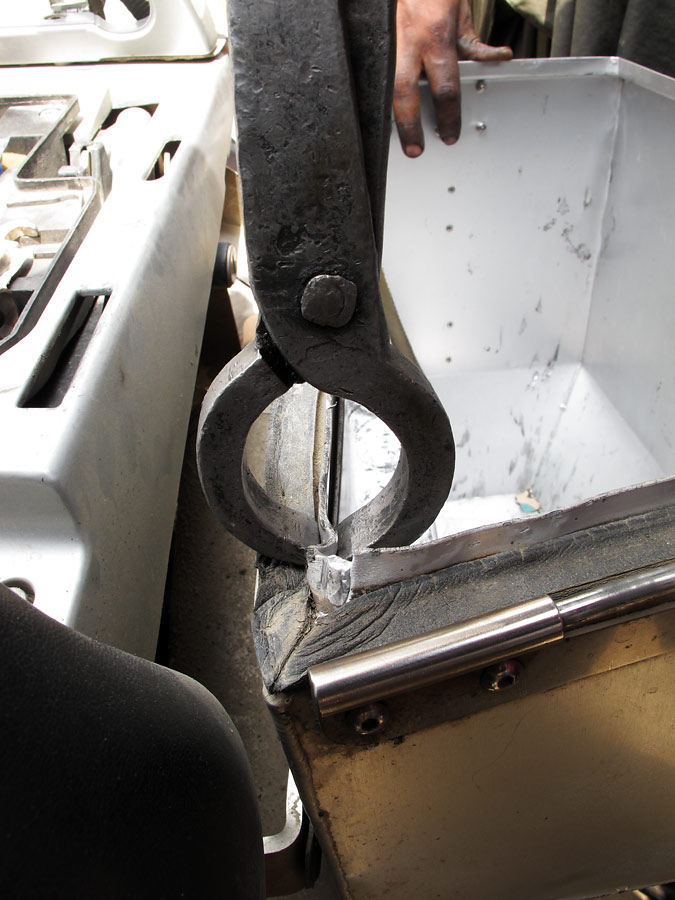
Using robust Pakistani villager's methods to make primary repairs.
Exhausted, and soaked in sweat, we checked into the first hotel we could find. It was an expensive one, but there was no energy nor motivation left to go looking for alternatives.
Frustrated, we spent the night trying to understand what we had done wrong to deserve such a reception. Or, on the contrary, had there been someone looking after us, a guardian angel perhaps? Trying to think positively, it was a lucky accident afterall.
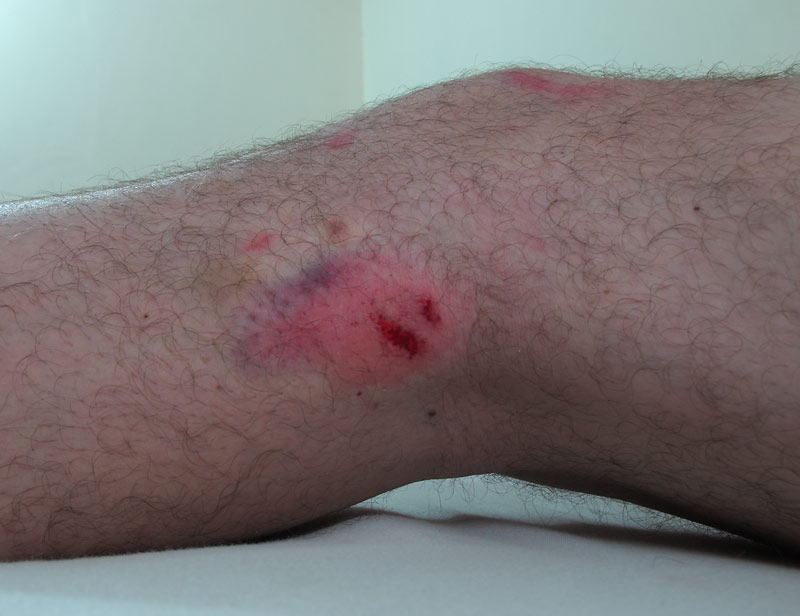
My busted leg.
Next day we rolled on. The traffic dissipated a bit, but the road deteriorated, too. Where the road traversed the areas of Indus Kohistan kids threw rocks at us, and we had an exceptionally shocking moment as we almost ran over a girl running across the road. She just ran onto the road from behind a parked car, and no braking would not have saved her if she would have noticed us coming. No doubt she would have been petrified right in the middle of our track. But the guardian angels (hers, not ours - our credit must have already expired) must have been on the watch as she just kept on running, without looking, so we passed her with an inch or so. Would it have been a car, the ending would have been different. Worst of all, when we looked back at the parents standing aside the road, they did not look shocked at all, just as if it were normal for their kids to have such close calls.
Welcome to Pakistan indeed!
The further north we moved along the Karakoram Highway, the more relaxed the people became though. When we stopped at some village to buy a bottle of water, the faces in the crowd that surrounded us were speaking a different language. Sure there was some distrust towards us as foreigners - some preferred not to join the crowd but to observe us from the distance, but there was a sense of positivity and curiosity, too, that we had not felt in the areas further south. In any case, being surrounded by men wearing the funky pancake hats we did not feel unfomfortable or unsafe. Maybe it is the following scene that gave us more confidence. Just as I took out the camera, an old guy with a crumpled nose insisted I take a picture of him. Others started laughing, obviously pointing out that he did not quite fit the parameters of a photo model. He laughed, too, and there were no hard feelings. It is nice when people do not take themselves too seriously.
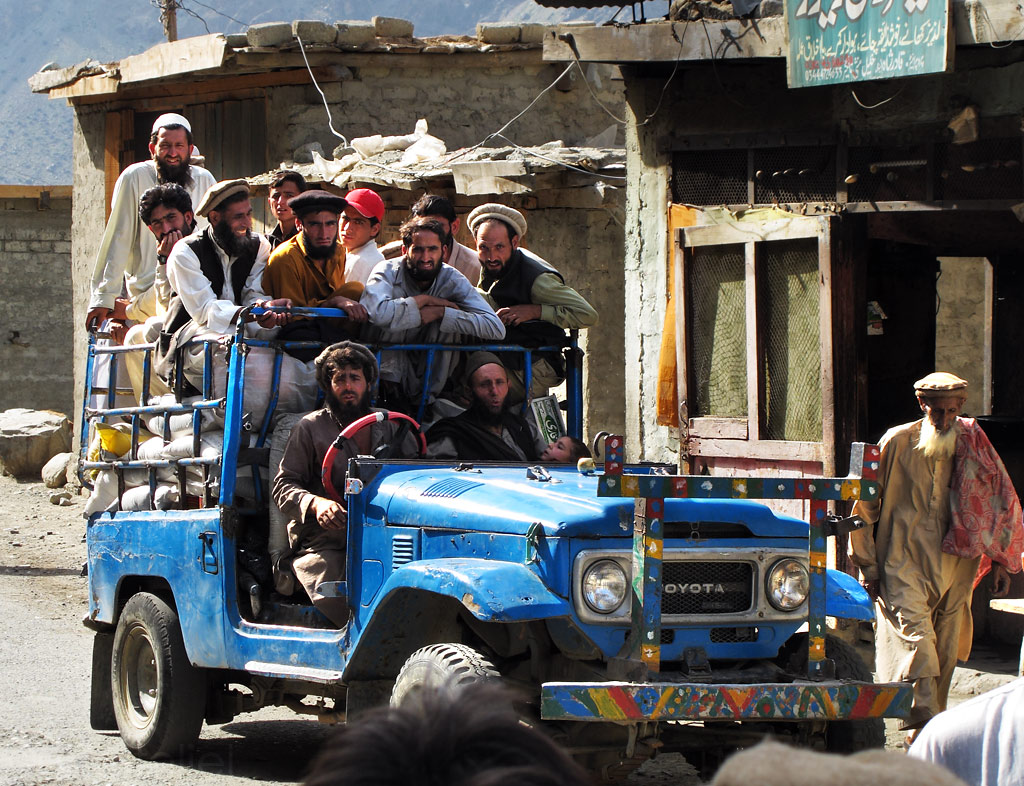
Typical Pakistanis on wheels.
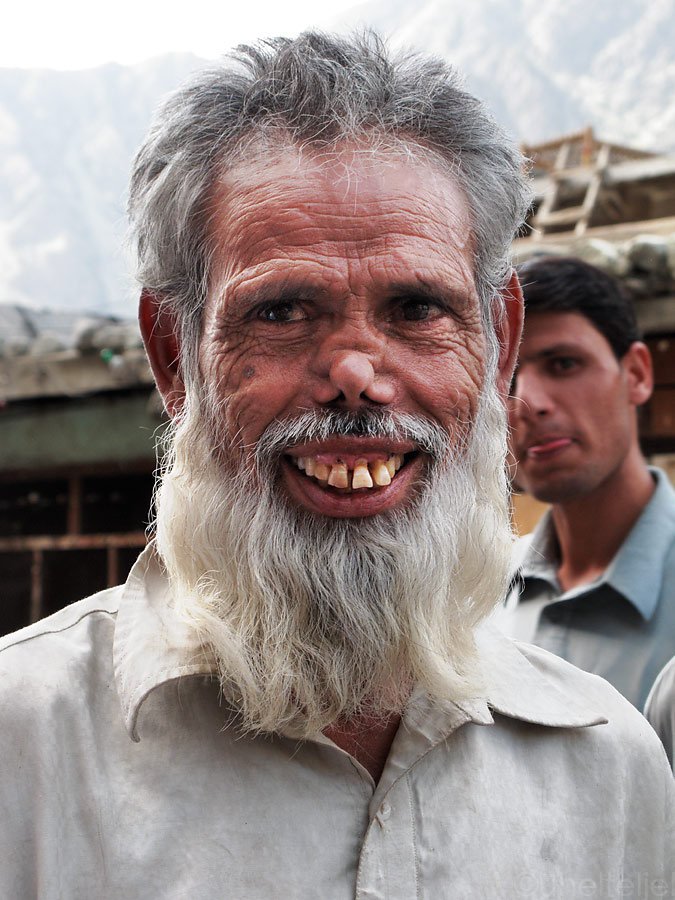
A funky old man.
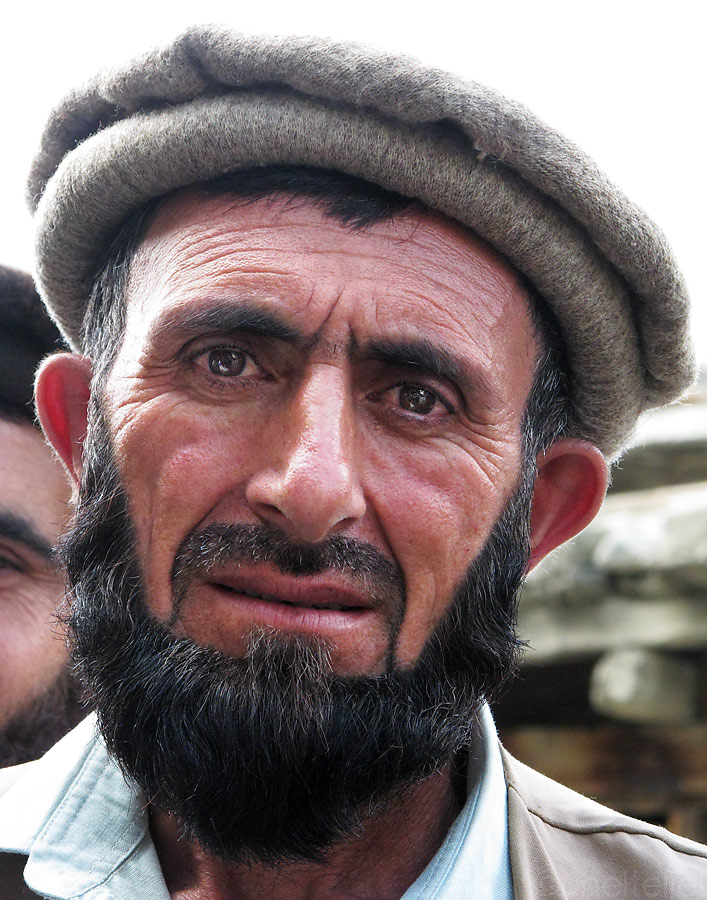
Pakistani Muslims in their "pancake" hats.
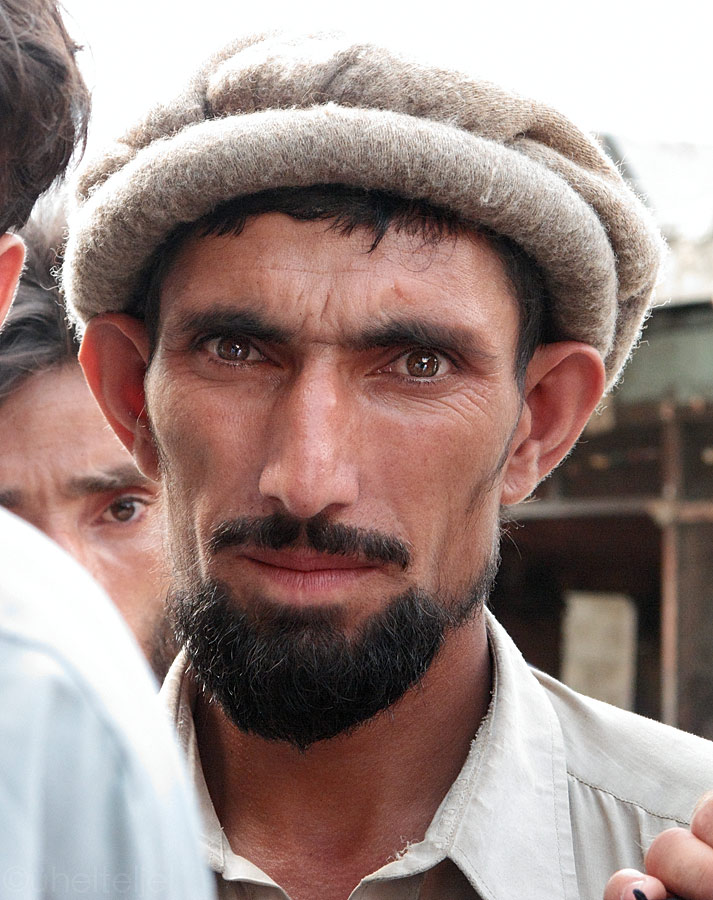
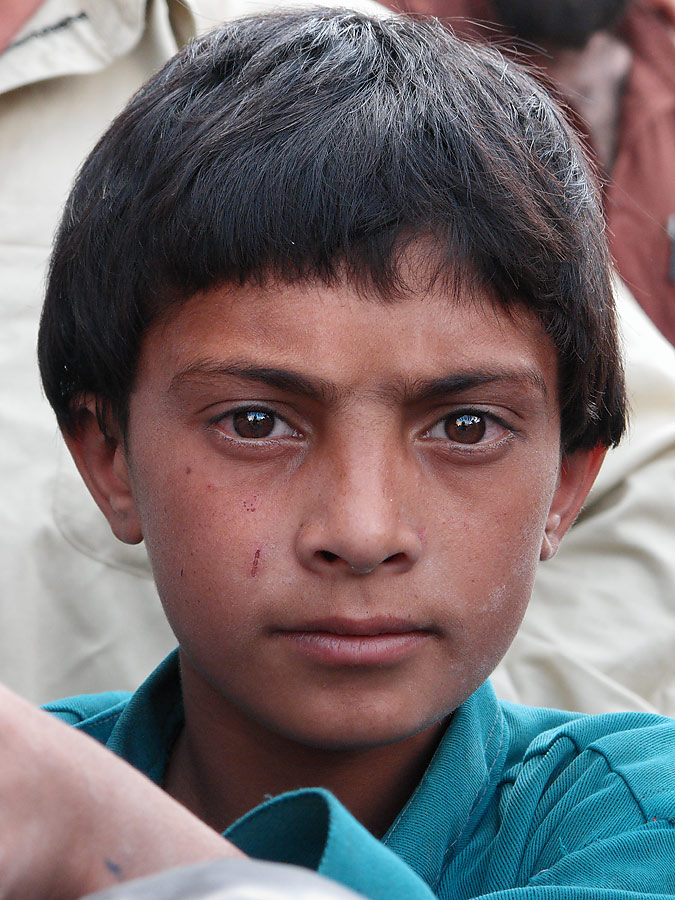
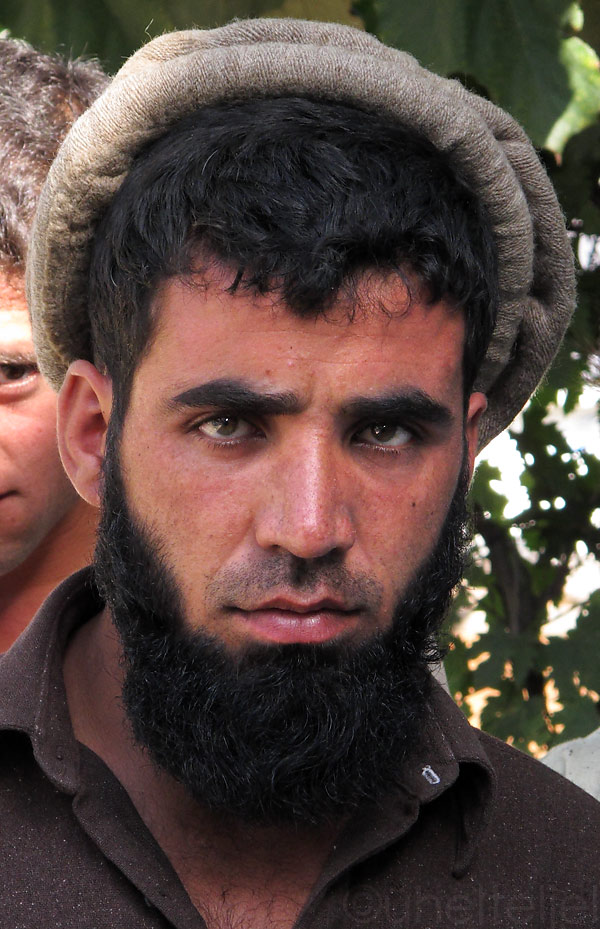
One of the mullah's inspecting us in Chilas.
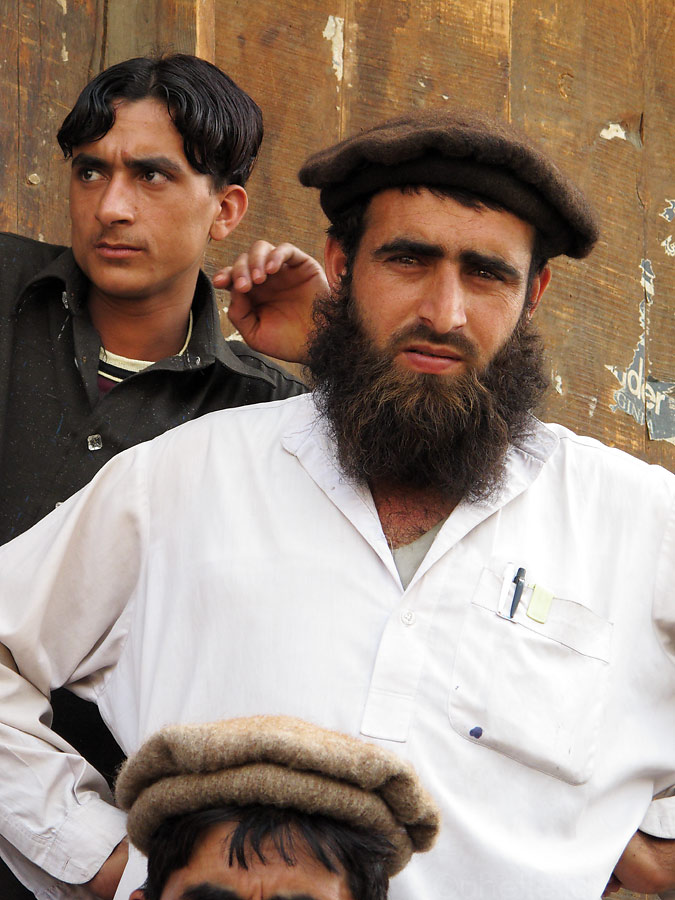
A decent beard is a Muslim man's pride.
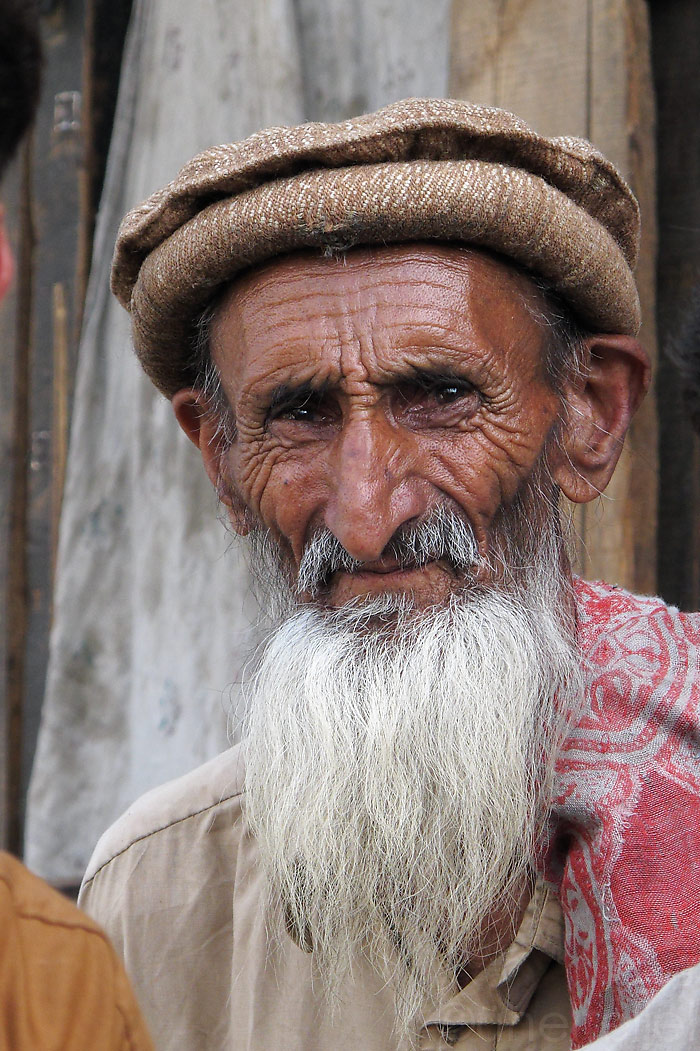
Rolling on, we soon started to realise what we had come here for. The ninth highest mountain in the world, Nanga Parbat, was standing before us (well, actually behind us - hadn't I looked in the mirror we would have had missed it!). Standing 8126 meters (26 660 ft) high, it is the westernmost 8000+ mountain in the world.
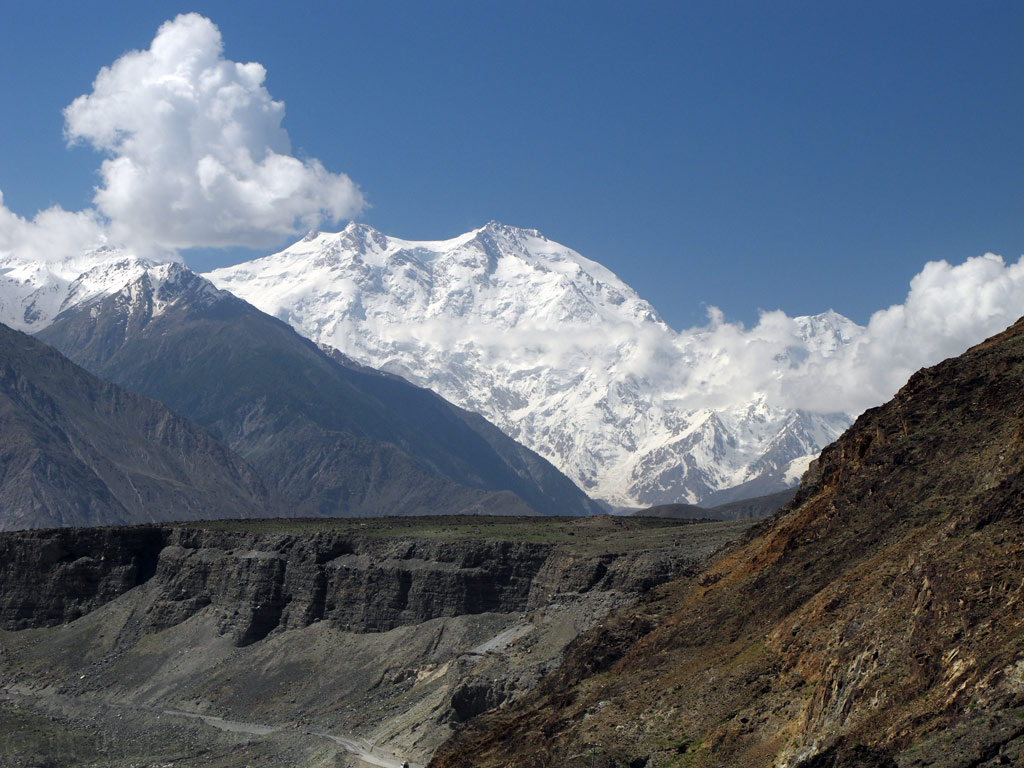
Nanga Parbat - stunning 26 660 ft!
But there are other, lower but still attractive peaks as well, many of which can be contemplated from Karimabad, the capital of the ancient kingdom of Hunza, even without any major hiking. For example Rakaposhi (7788 meters), Ultar II (7388 meters), Diran (7270 meters), Hunza Peak (6270 meters), Bubulimating (6000 meters), Altit Peak (5075 meters).
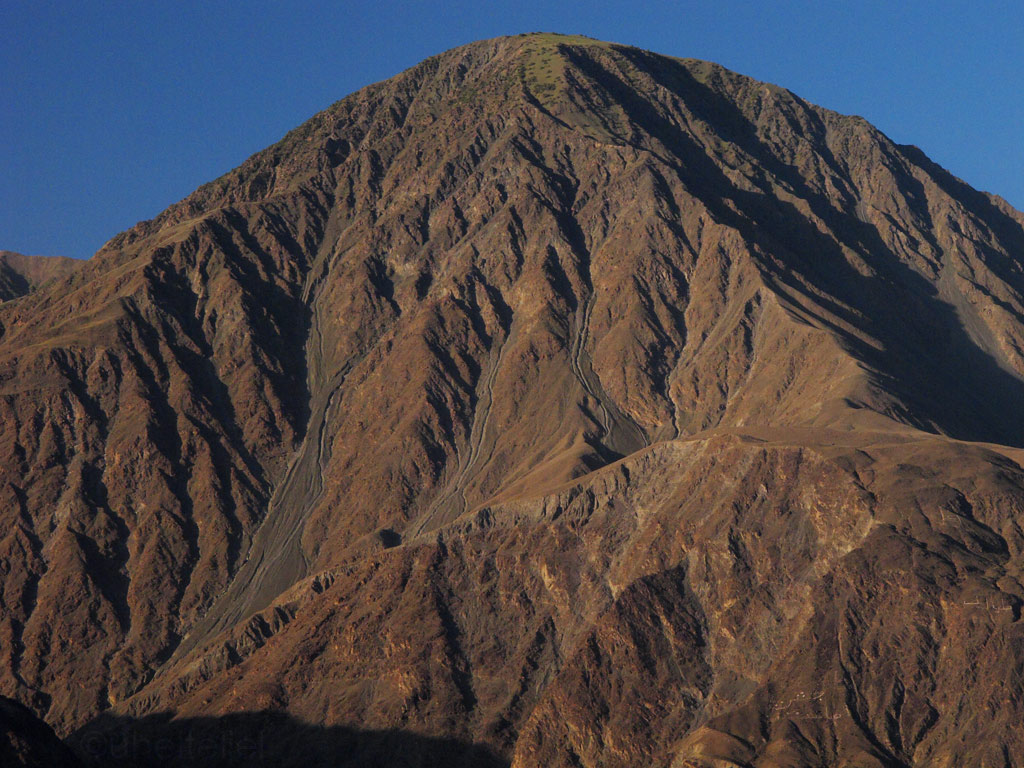
Mountains seen from Gilgit.
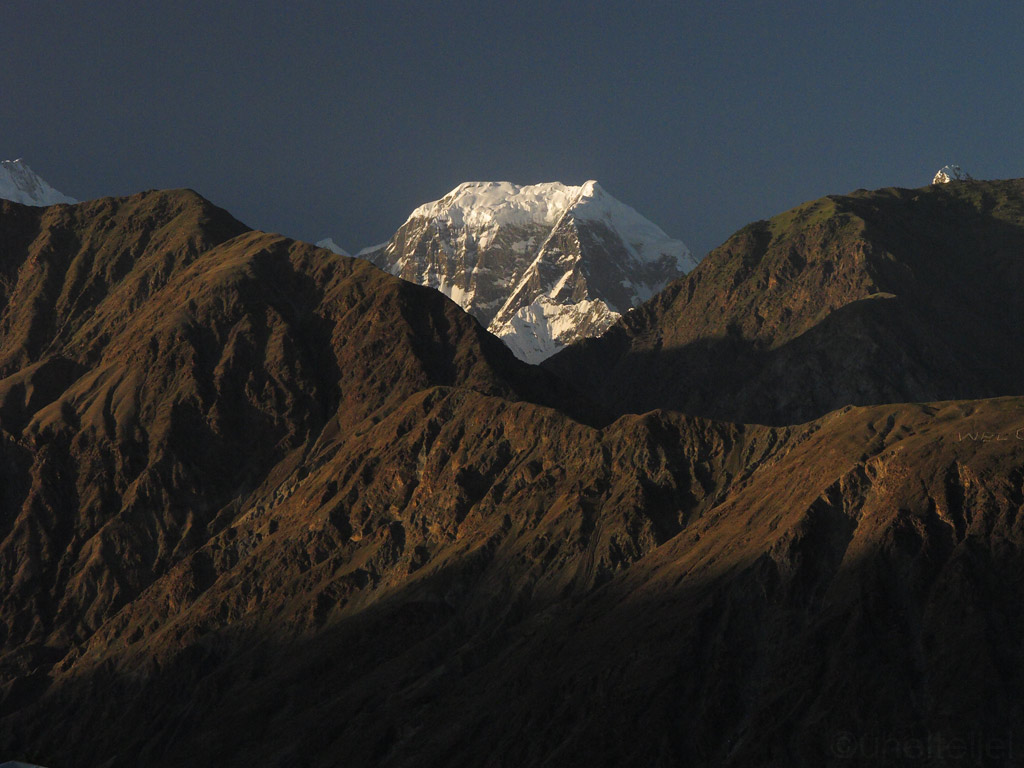
A white cold top surrounded by warmer lower mountains in the last sunlight.

Panorama from Gilgit (click to enlarge).
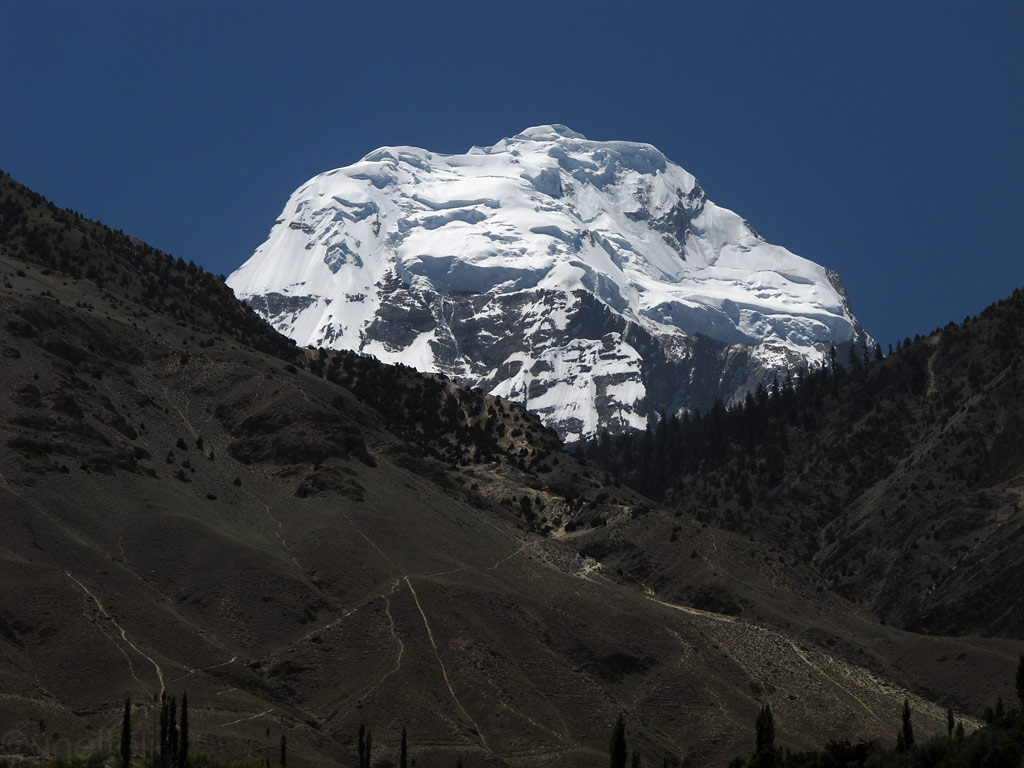
A white top in Karakoram.
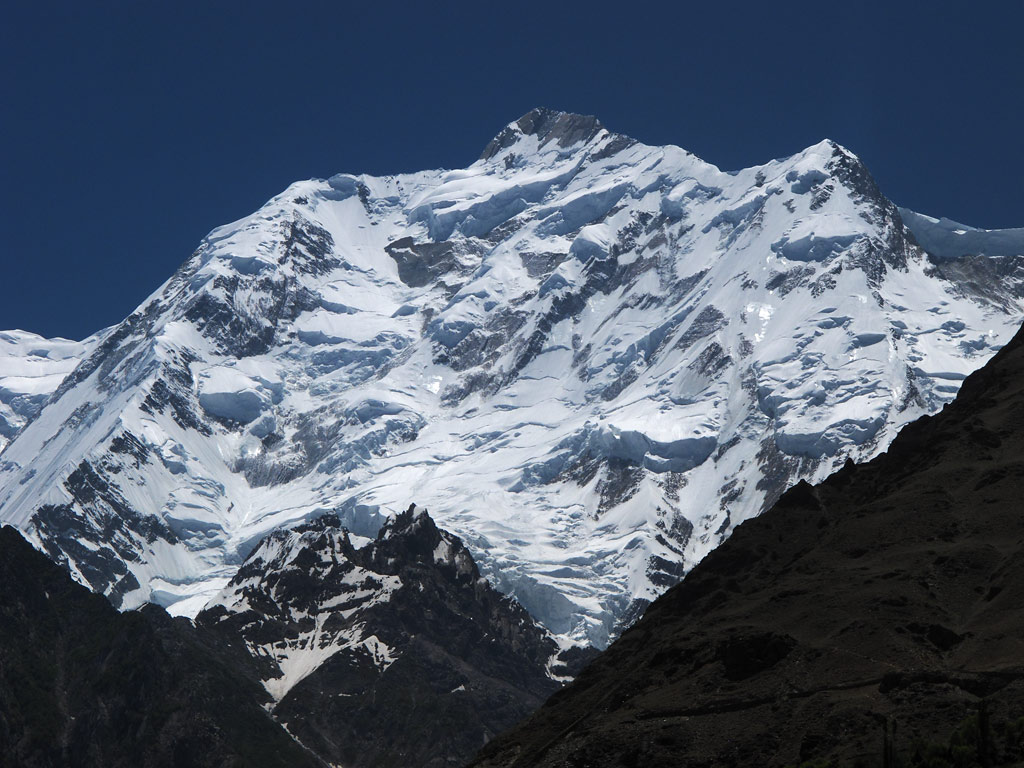
Rakaposhi (25 550 ft)
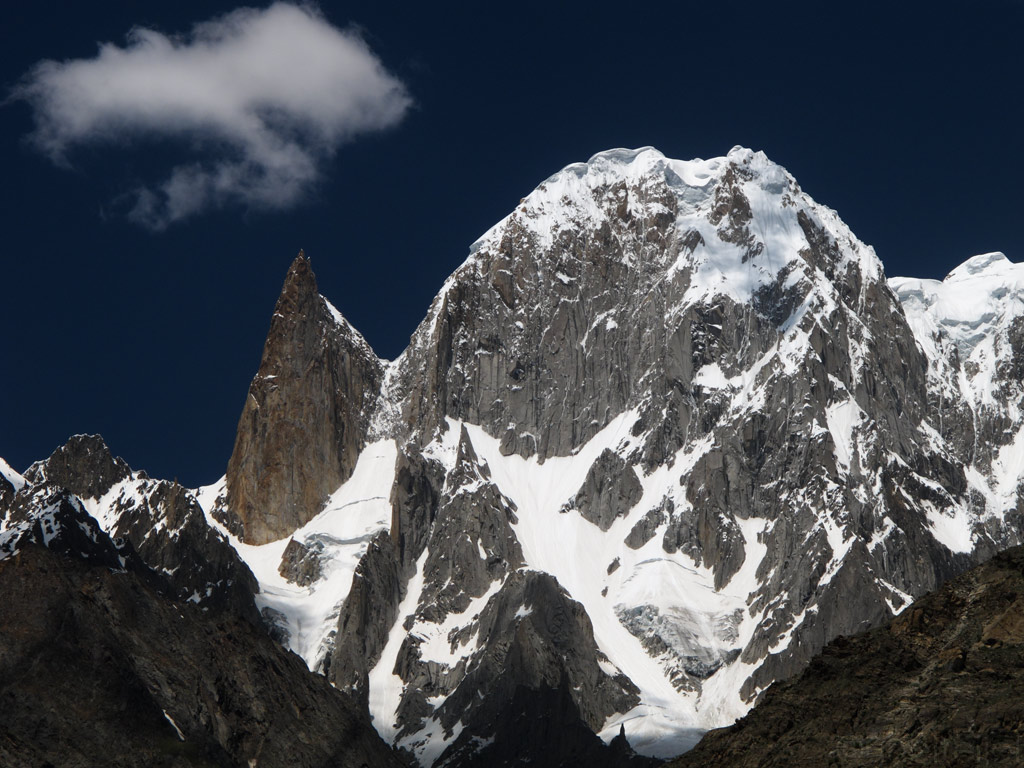
The sharp peak on the left is called Lady Finger (Bubulimating in local language), sided by Hunza peak.
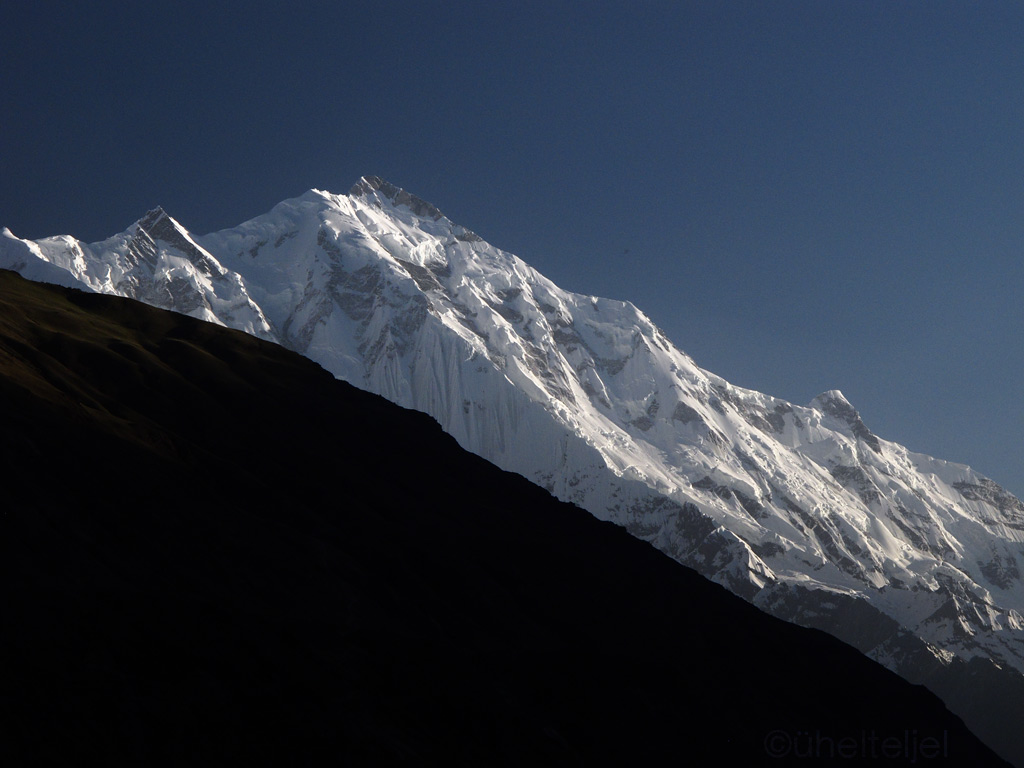
The mighty Rakaposhi from another angle and lit up by the last sunrays.
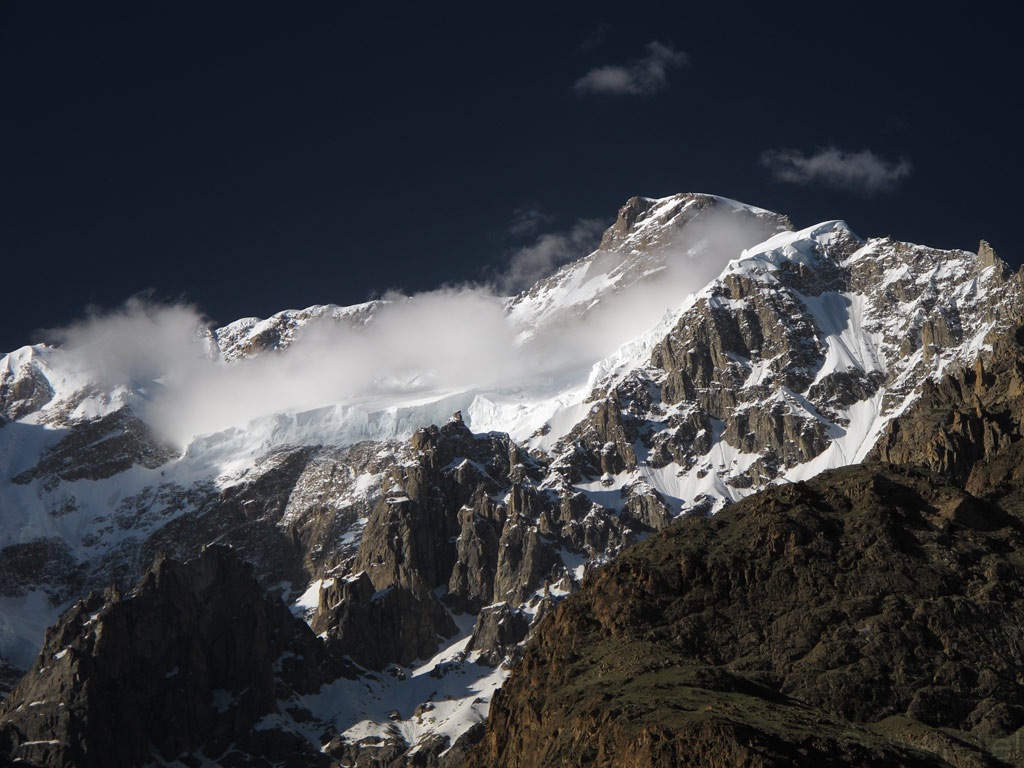
Altit Peak.

Panorama of the Ultar II (24 200 ft) - click to enlarge.

Panorama of Rakaposhi (click to enlarge).

Panorama from different peaks seen from Duikar (click to enlarge).

A looong panorama from Eagle's Nest viewpoint in Duikar - a decent view of the Karakoram's might (click to enlarge).
Hunza is roughly the region where the Asian and Indian plates collided millions of years ago. The process of terraforming is far from being over, though, as the Indian continent still keeps on moving north. Thus it is only logical that the earth trembles here some every three minutes or so. This, of course, leads to landslides.
One major landslide took place here in January this year, blocking Hunza river and subsequently creating a lake that is by now some 100 meters deep and kilometers long. The problem is, that a part of the Karakoram Highway, the only connection road to the Chinese border now lay submerged together with some villages. Unable to clear the rubble that is damming the river, the locals have introduced boat transport across the lake.
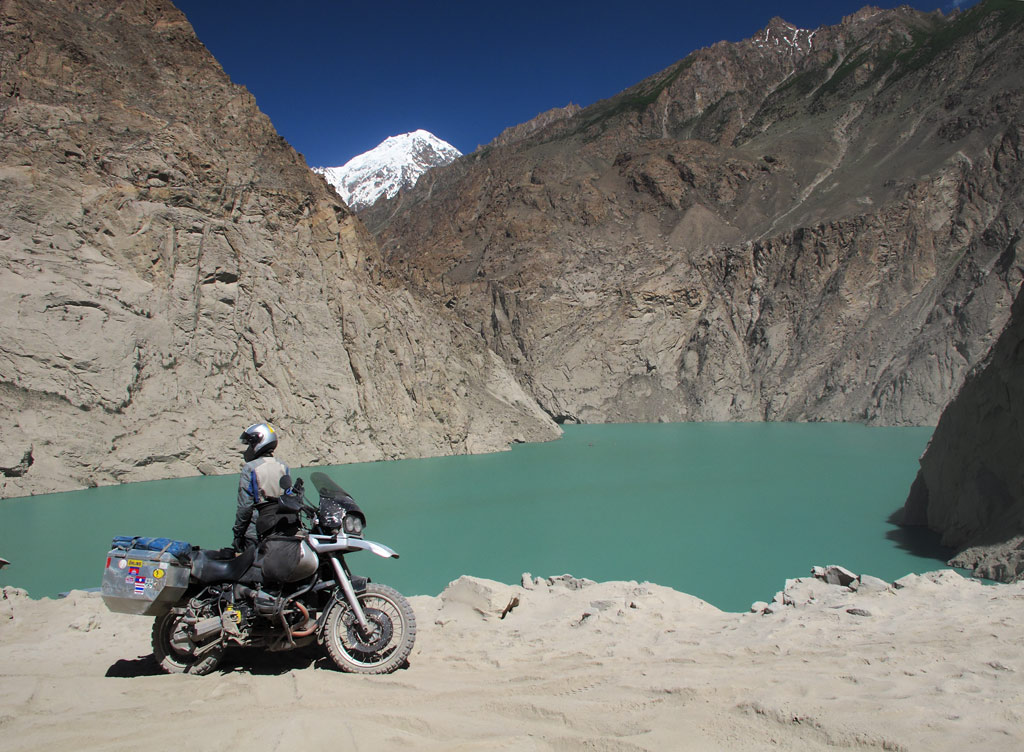
Hunza lake - created by a gigantic landslide and has drowned KKH road along with number of villages.
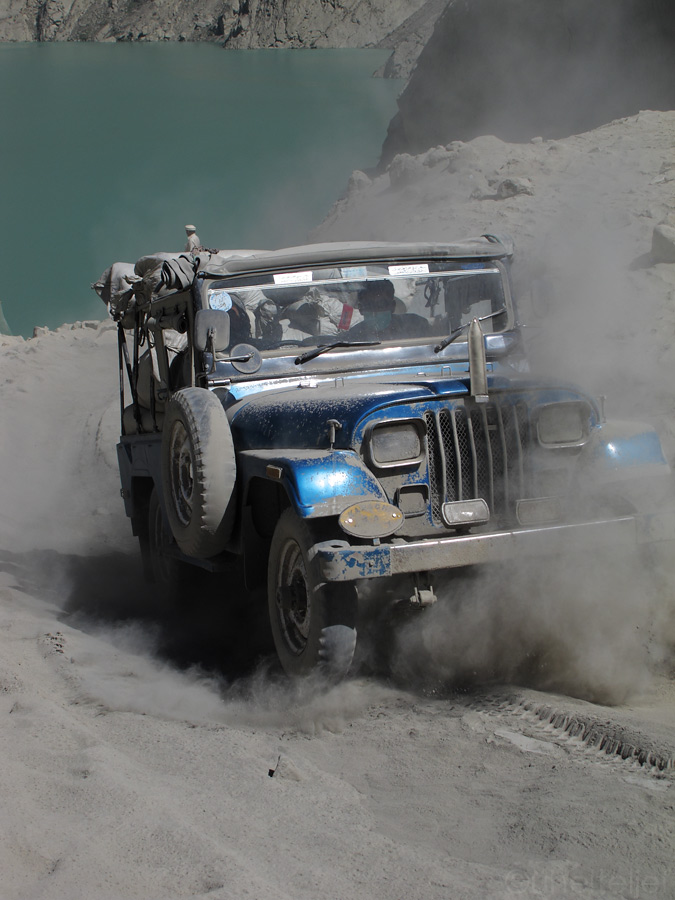
4x4 is a preferred way of transport on KKH.

Panorama from the Hunza lake (atop of the landslide itself) - click to enlarge.
Hunza was indeed the most pleasant region we had visited so far in Pakistan. Not only has it the views, but the people are different here. Maybe it is the cooler mountain air, or maybe it is because the people here follow a different branch of Islam, namely Ismailism. One of the first things to notice here is the presence of colourfully dressed (no burkas!) women in the streets, but the overall attitude of the locals is much more positive and relaxed than elsewhere.

Panorama from the road (click to enlarge).
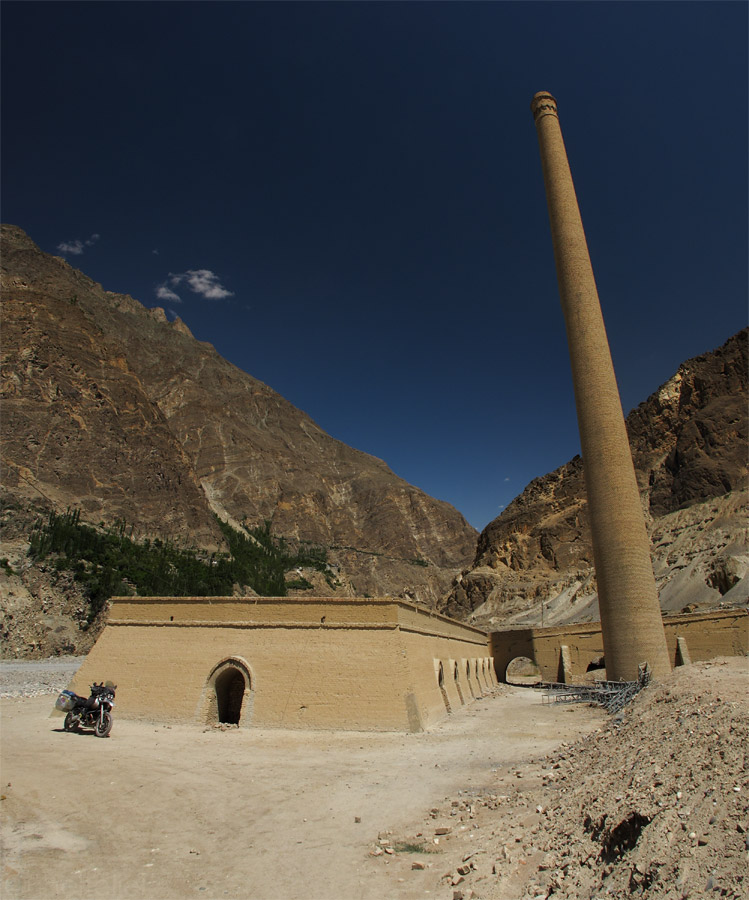
A brick factory aside the Karakoram Highway.
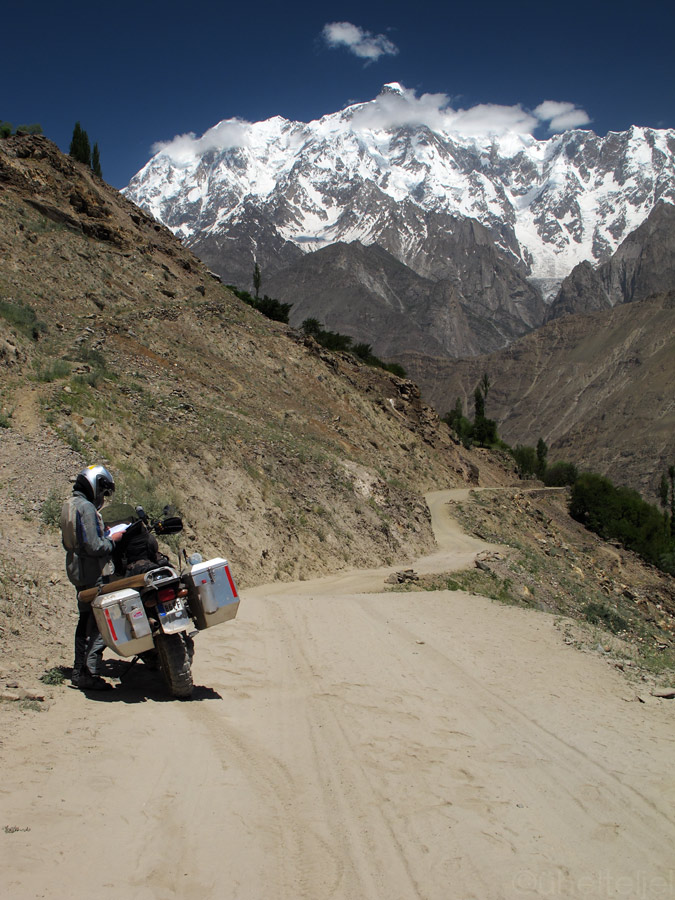
Road from Hopar - Ultar II glowing in front of us.
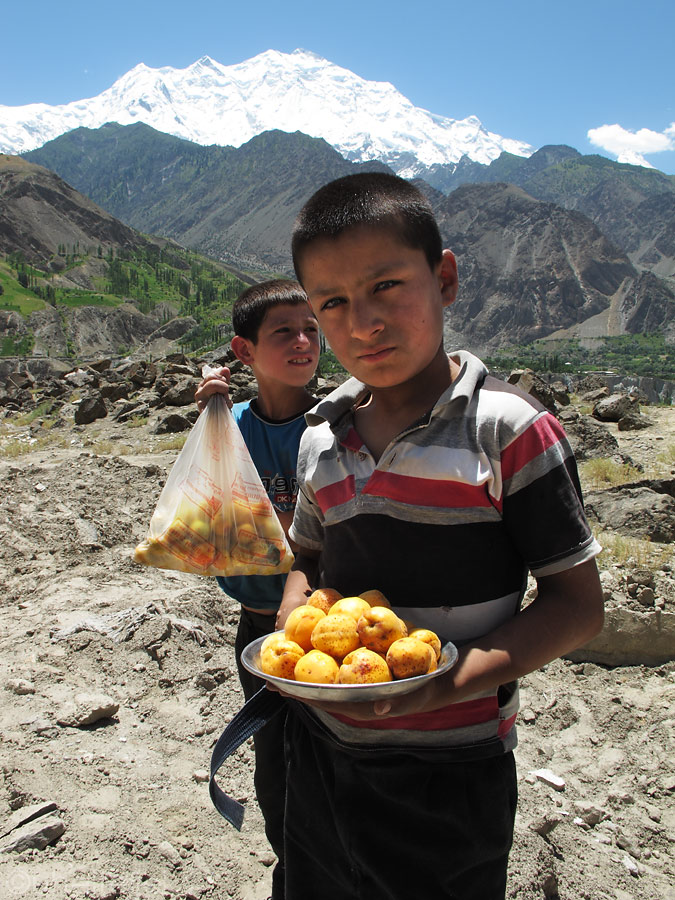
Apricots in Hunza valley are world famous, fed by Karakoram's rich minerals and baked in high altitude sunlight - they taste good indeed!
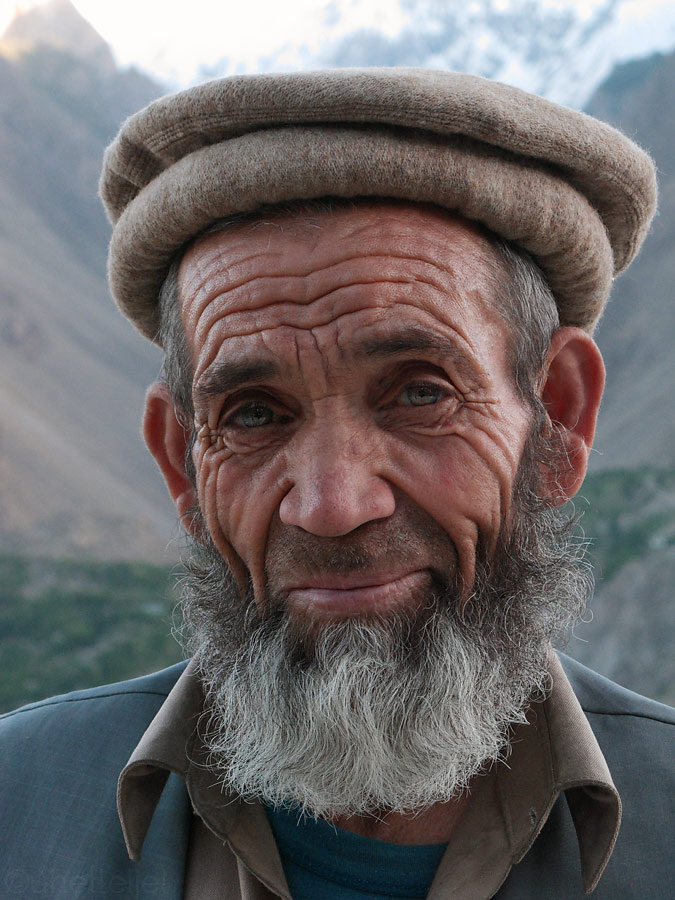
Ismaili muslims in Hunza are friendly and welcoming.
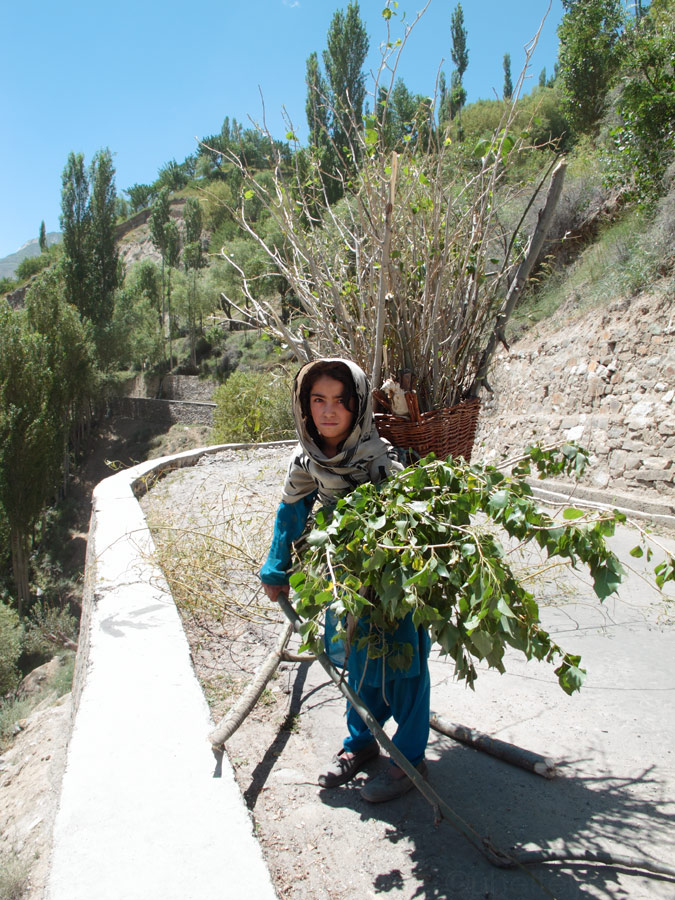
Young girl at work.
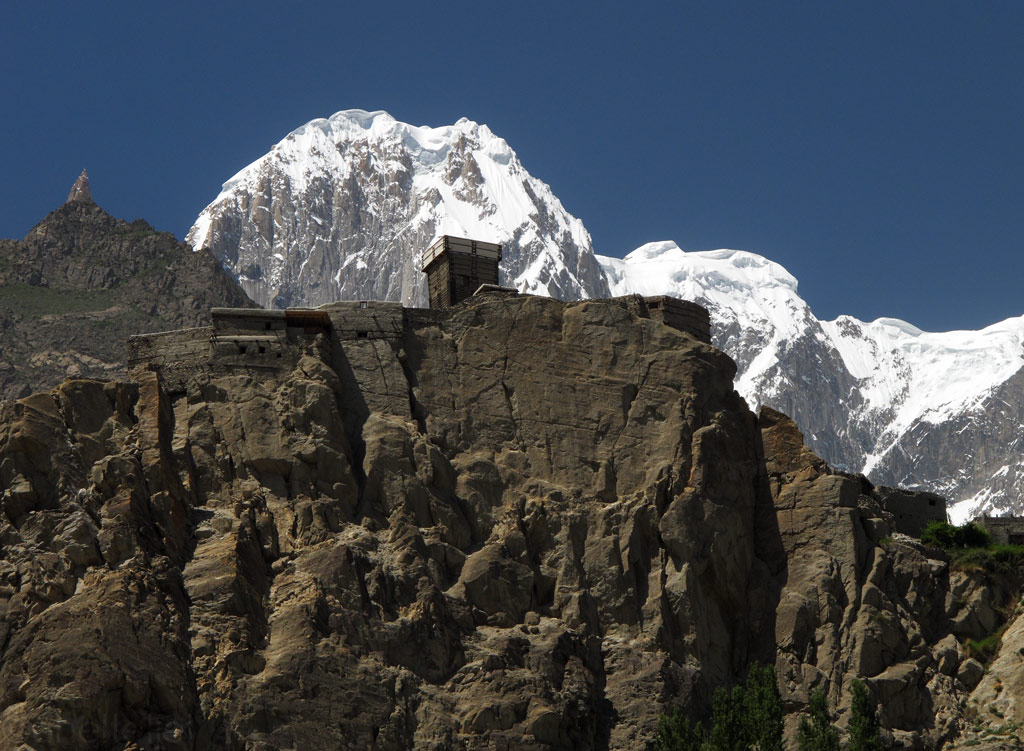
800 years old Altit fort on the backdrop of the Hunza Peak.
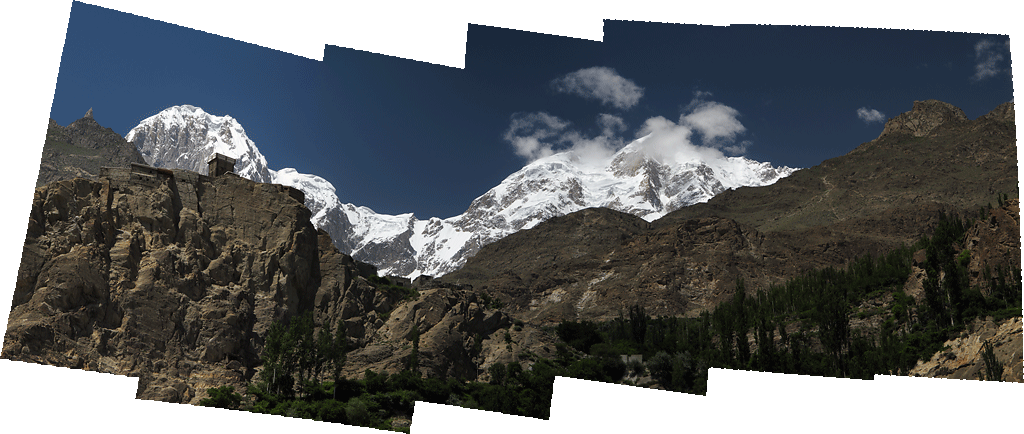
Panorama of the Altit fort.
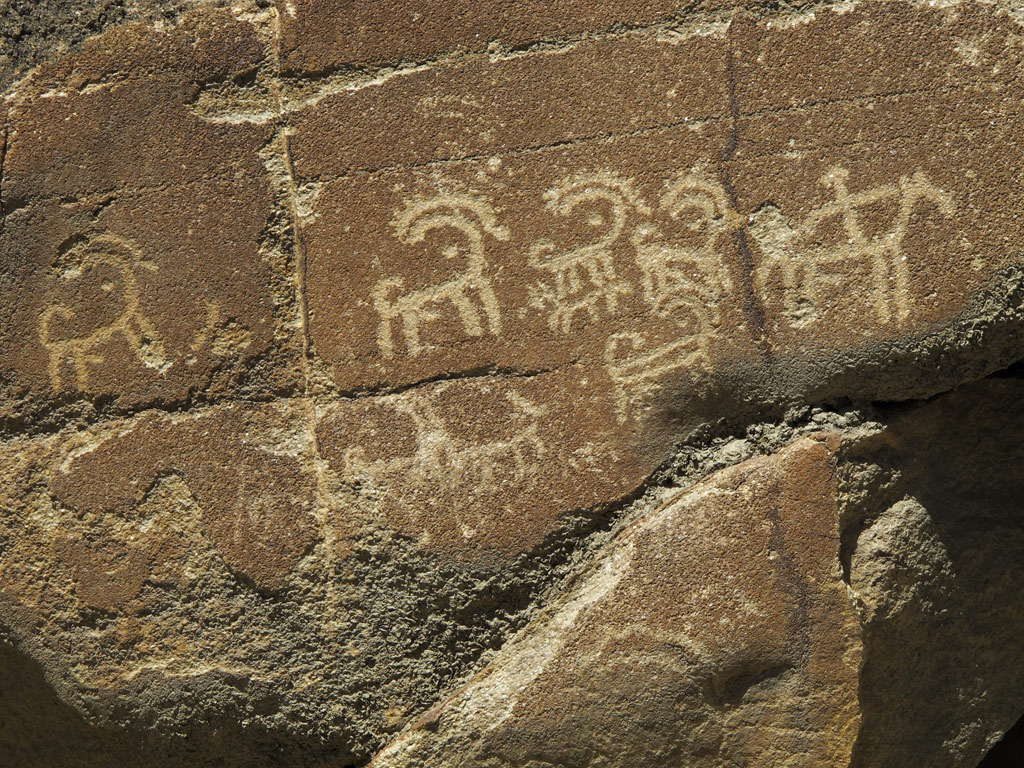
2000 year-old rock inscriptions in Hunza valley. Mostly reflecting hunting-scenes.
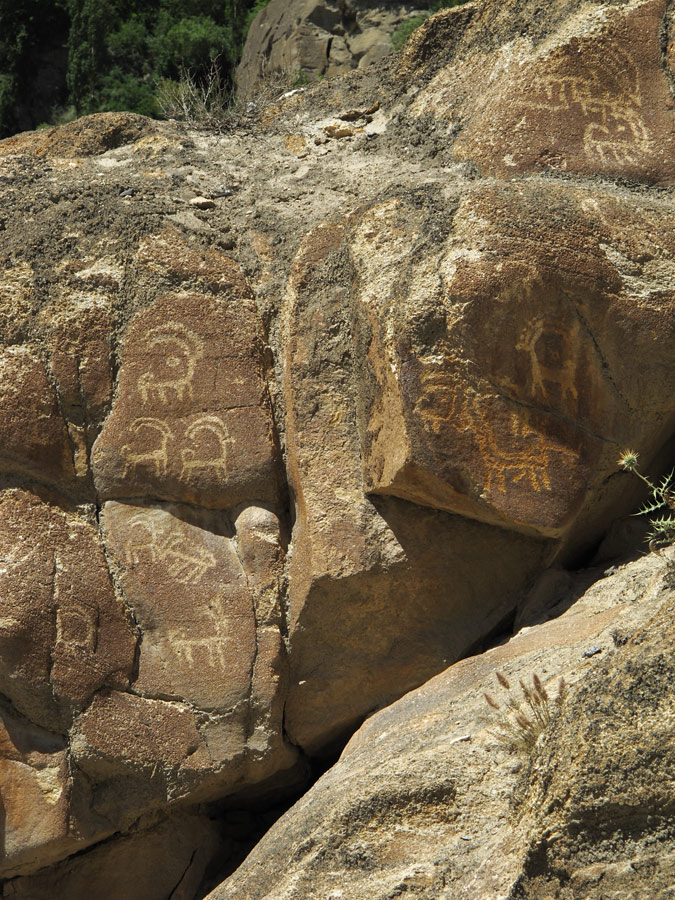
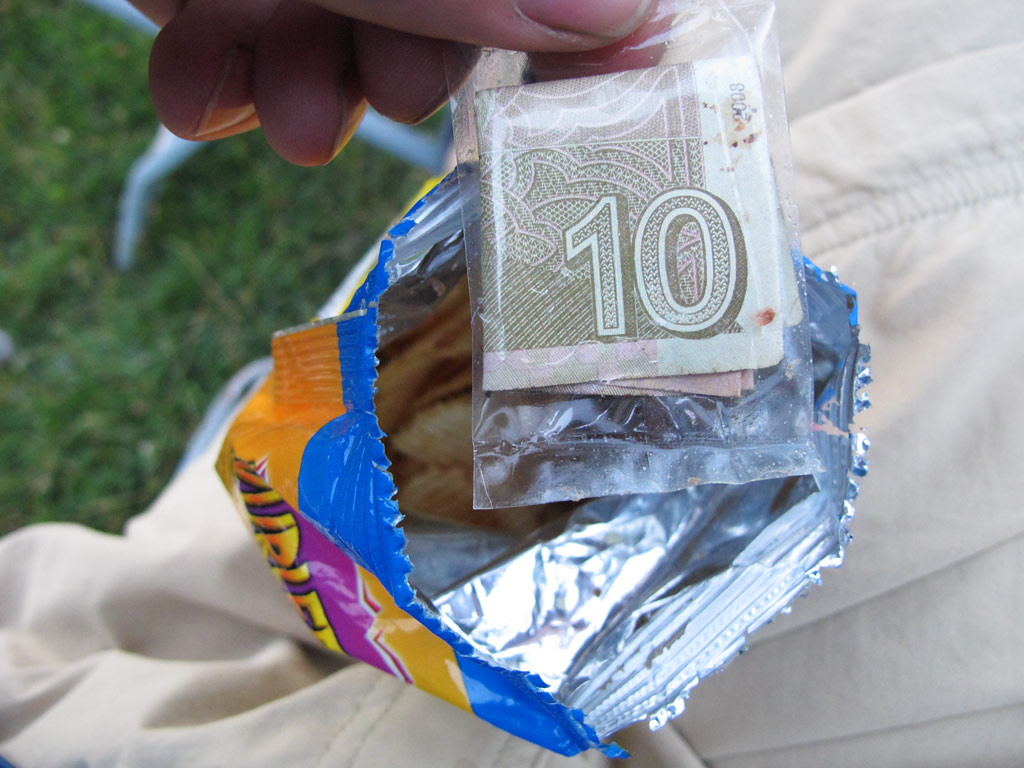
And, last but not least, we found a 10-rupee note in a bag of potato chips.
Soon enough we realised that the words of the guest house owner in Karimabad were true - Hunza indeed had some sort of magnet that did not want to let go of us. We had thought of spending there a couple of days, but ended up staying a whole week.
It was a relaxing time. The mountain views, good food and pleasant atmosphere all contributed to recharging of our batteries and harmonizing of our brain waves. Positive thoughts towards the future returned to us. It was a total zen, if you like.
The weather, actually, was nothing too special. Hunza is a relatively dry place, so that even during the monsoon season there is not much rainfall. Maybe it is due to the climate change that while we were there it rained two days in a row so that we could barely get out of our room. When the rain stopped, however, the receding clouds and the mingling light showed us the mountains at their most spectacular.
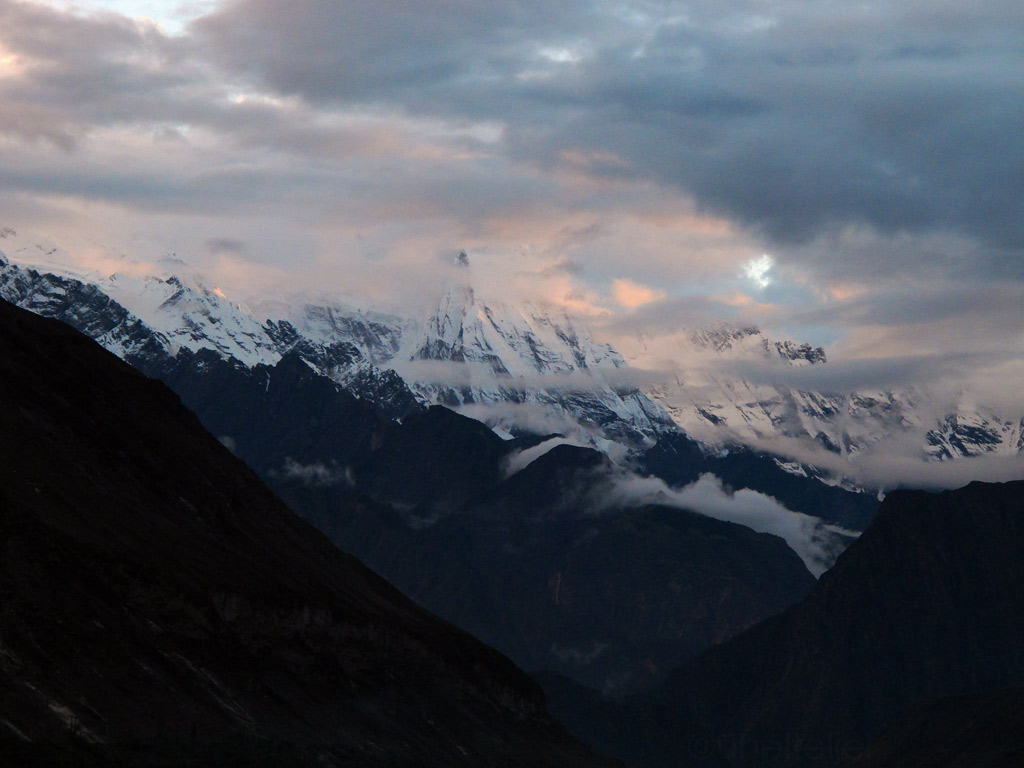
Light play...
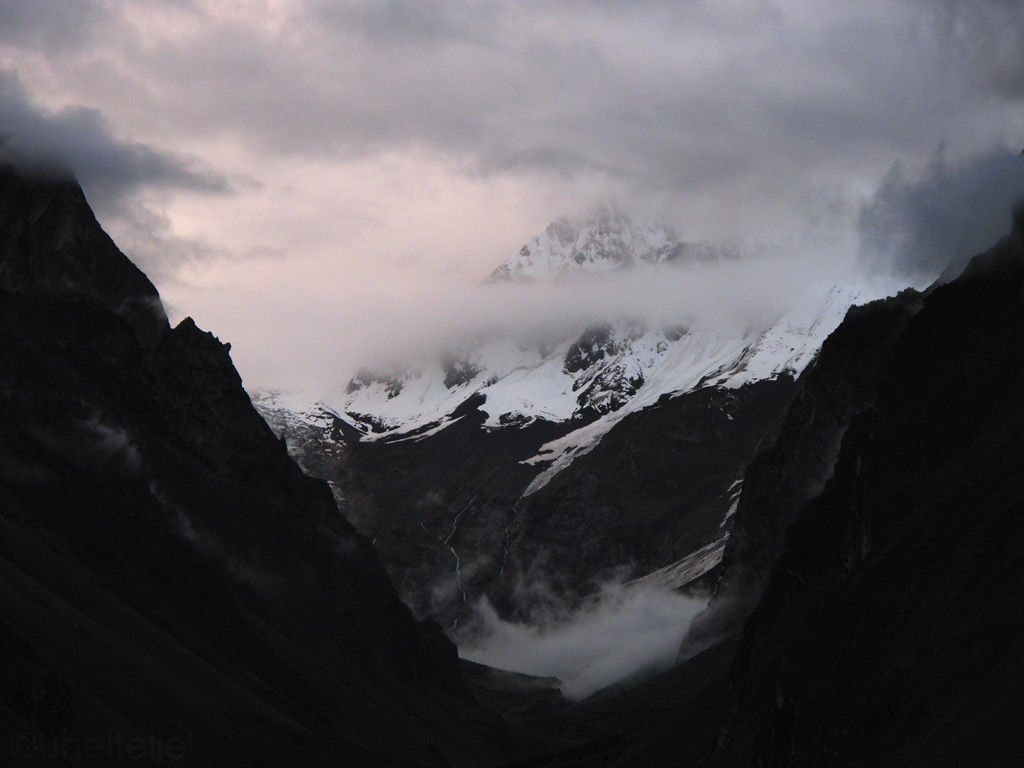
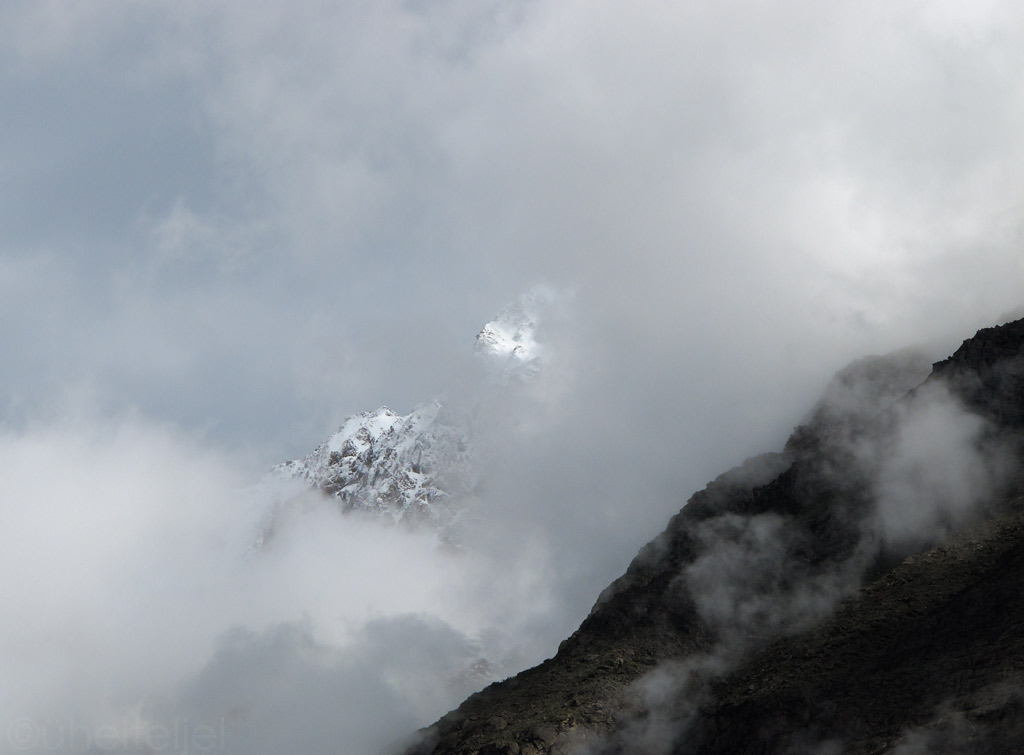
A white 25 000+ft top almost revealing itself...
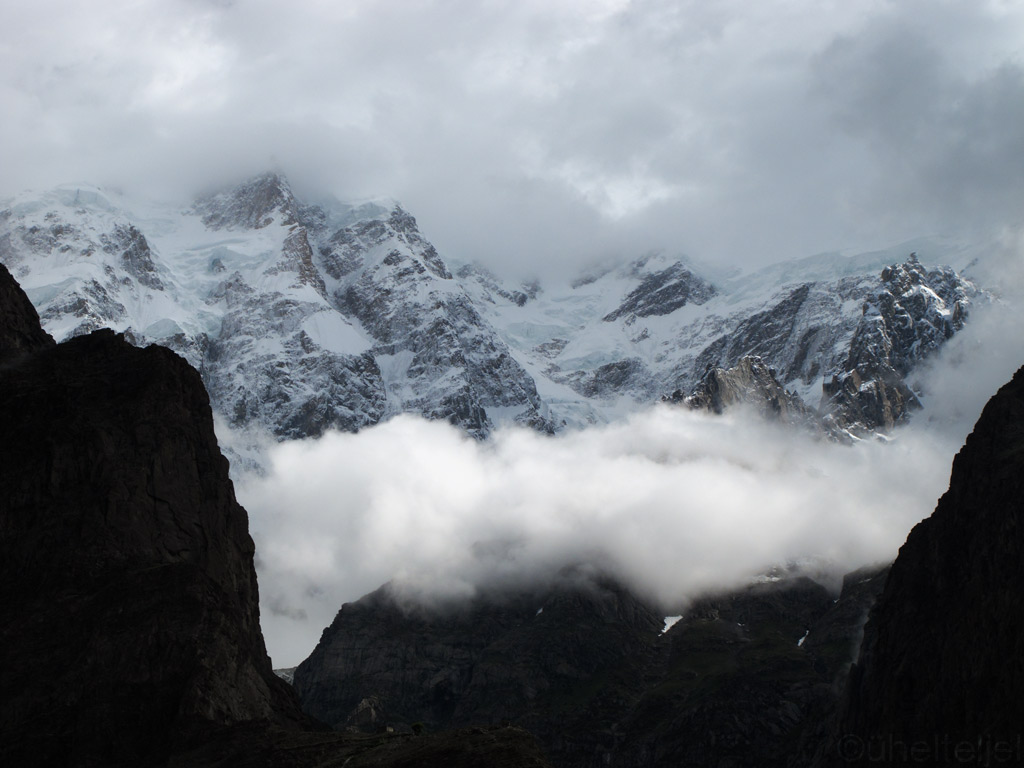
Ultar II, clouds above and below it.
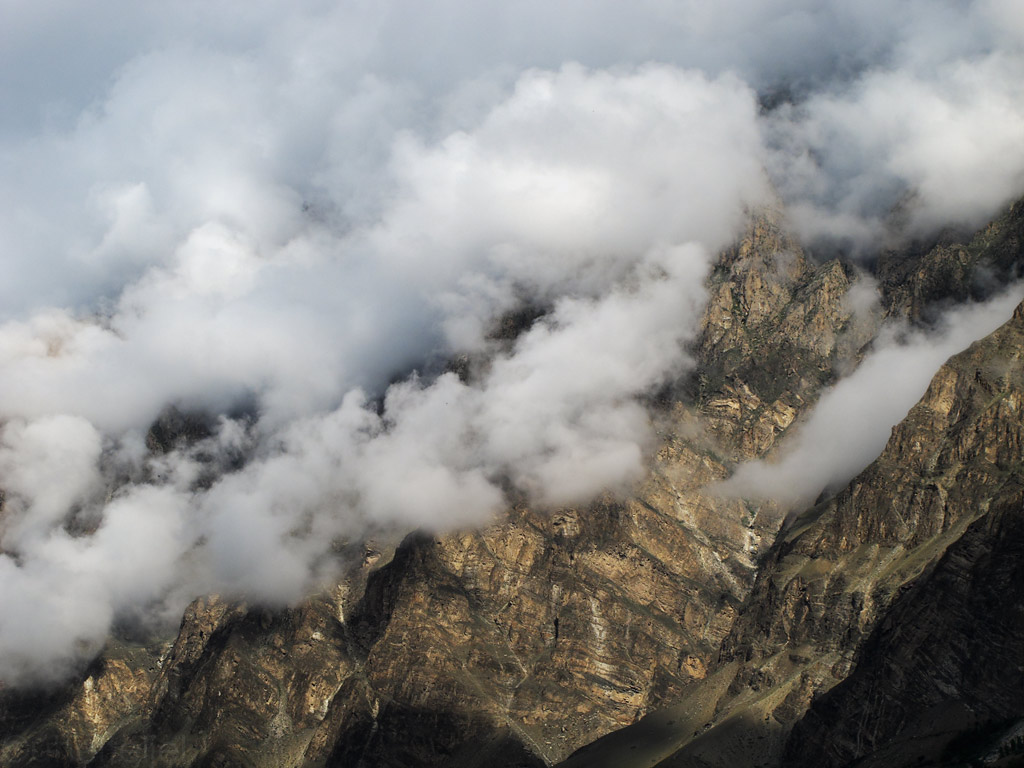
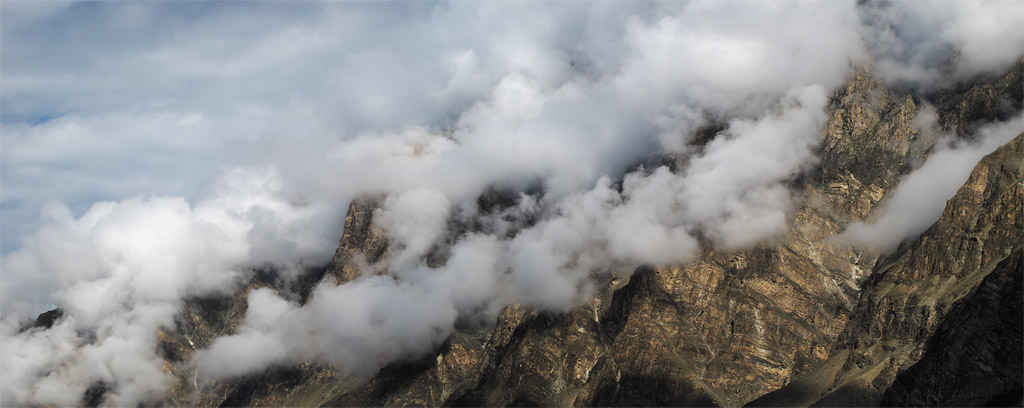
Panorama of Hunza valley's steep rocky sides (click to enlarge).
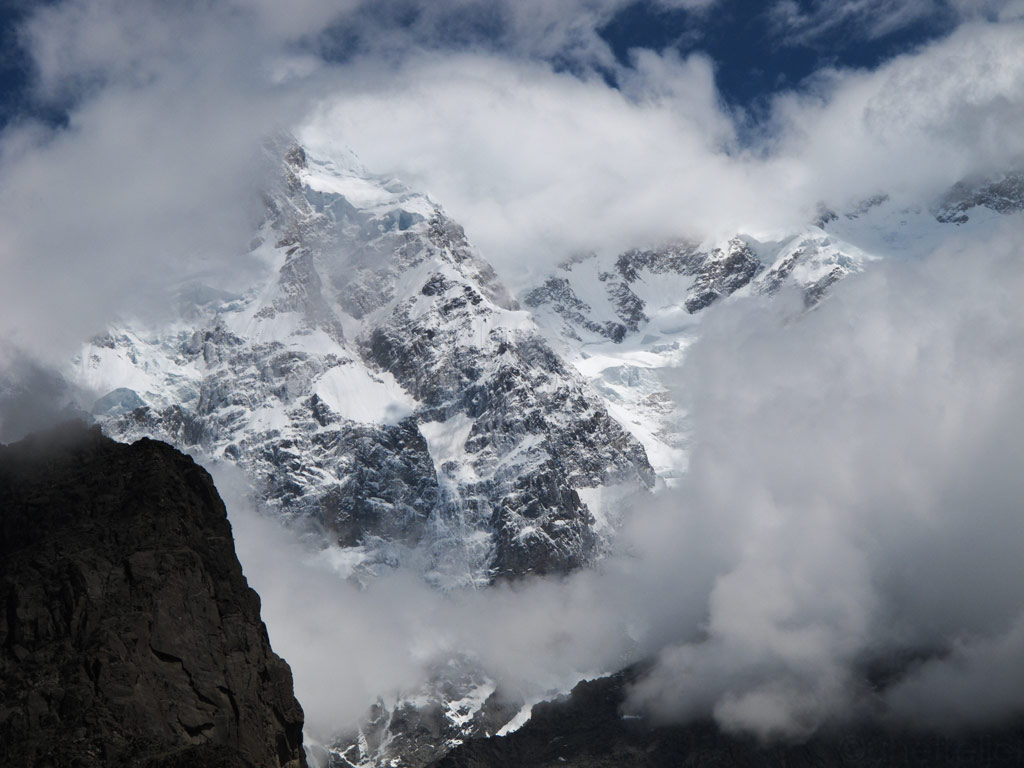
The view...

Panorama from Ultar canyon (click to enlarge)
Since there is not much precipitation, all life in Hunza depends on the glaciers and the meltwater. Without there would not be much more than rocks and sand. But as long as the glaciers are there (and there are loads of them in the area!), the friendly folk of Hunza may continue telling stories of their ancient kingdom while drying apricots on their roof tops. The apricots of Hunza are famous all over Asia, as well as the walnuts grown there.
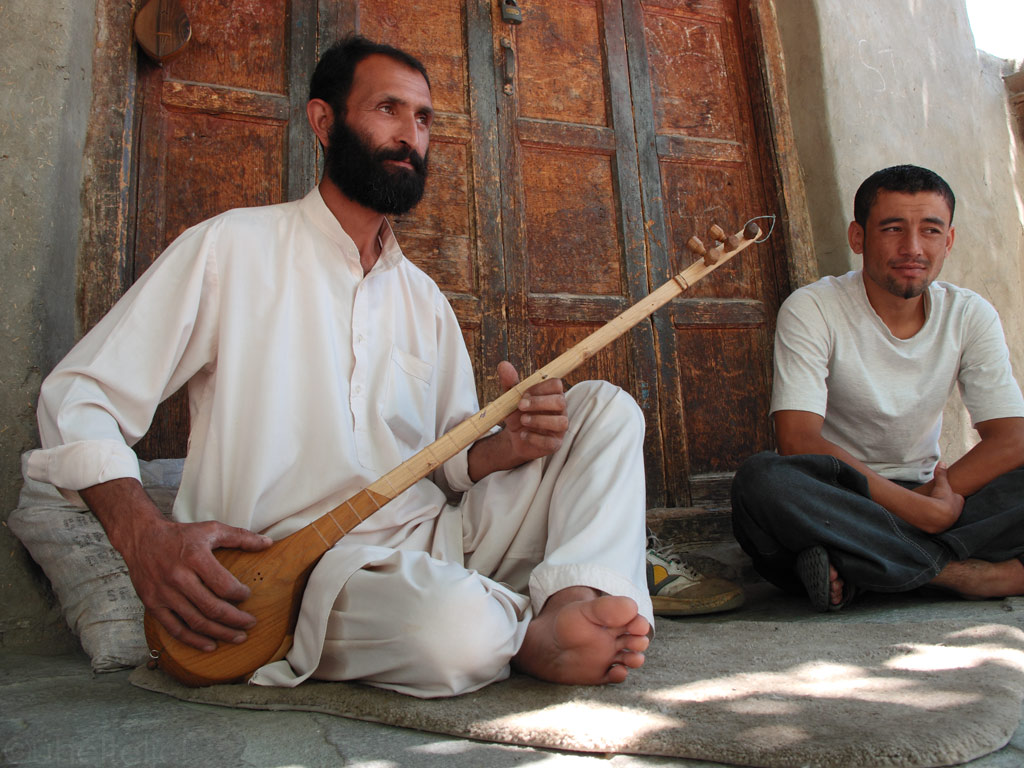
Hunza ismaili-muslim playing a traditional instrument in Karimabad.
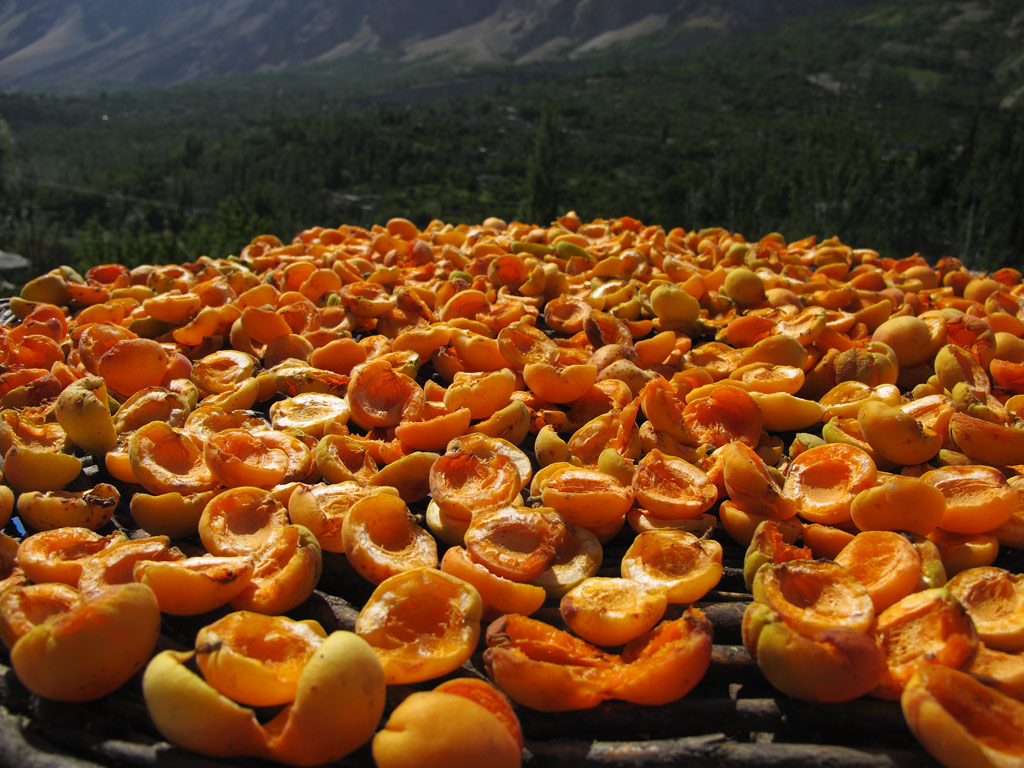
Apricots drying on the house roofs.
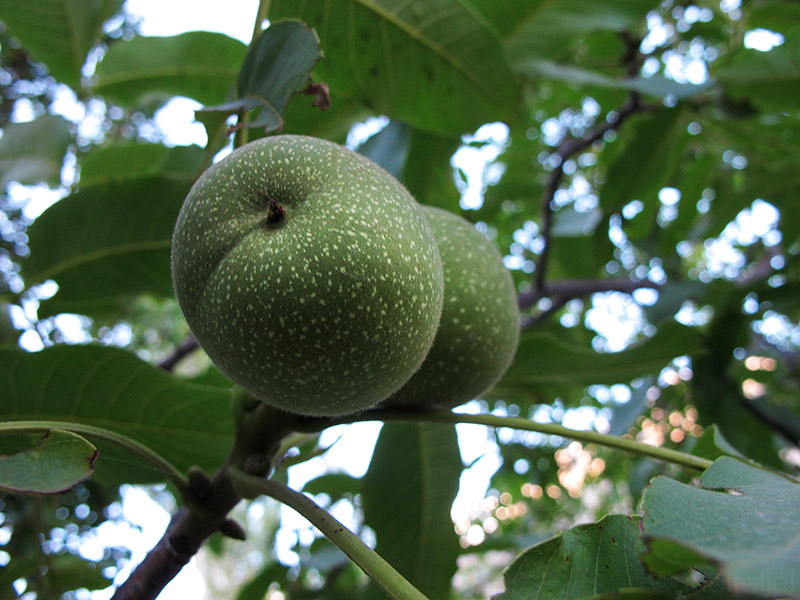
And walnuts are still ripening...
A long time ago, there were actually many kingdoms in this area. When Marco Polo visited in the 13th century, he said the place was "noisy with kingdoms". The kingdom of Hunza is however one of those few that have left a tangible heritage - both physical and cultural which is still visible today. It is interesting to point out that officially Hunza only adhered to Pakistan and the status of its ruler was decreased to a district official in 1974. The locals, however, are still fond of the old times and their ruler, and do not really think of themselves as of Pakistanis.
One of the more prominent reminders of the glorius past is the 13th century fort overlooking the village of Karimabad. It has played host to many a ruler, and the last one to live there only moved out to more modern quarters in 1945. The fort has seen many additions and modifications since it was originally constructed. In the 17th century for example, the ruler married a daughter of the king of Baltistan, who brought a bunch of masons as a dowry. This resulted in many Tibetan style additions to the fort, and this is probably why it is now called the Baltit fort.
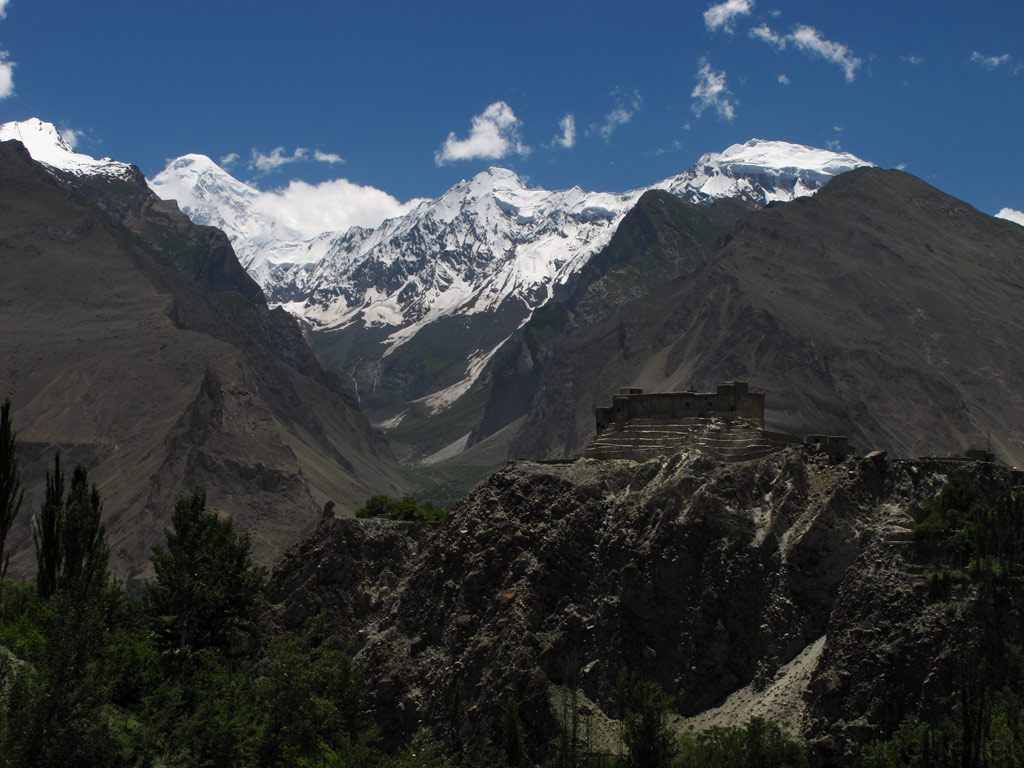
Baltit fort in Hunza valley.
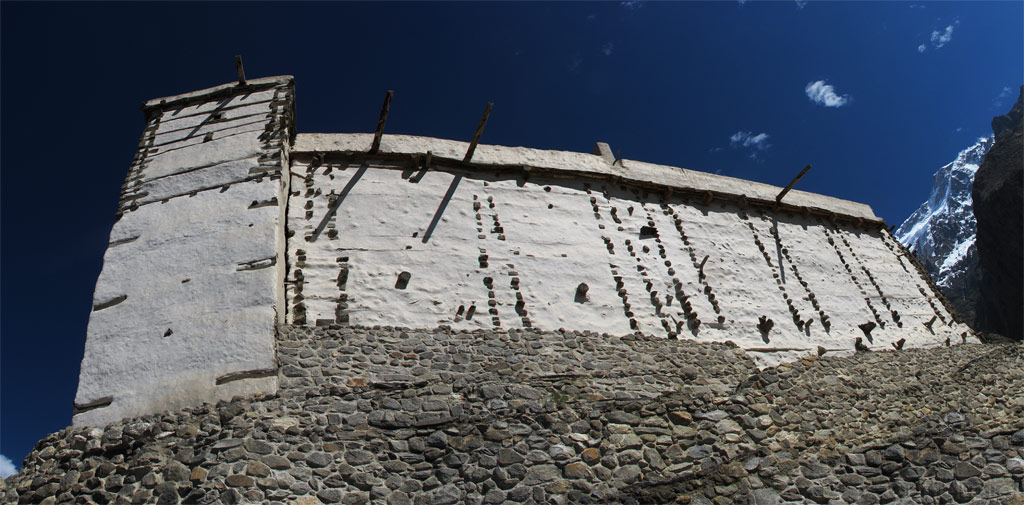
Wall of the fort.
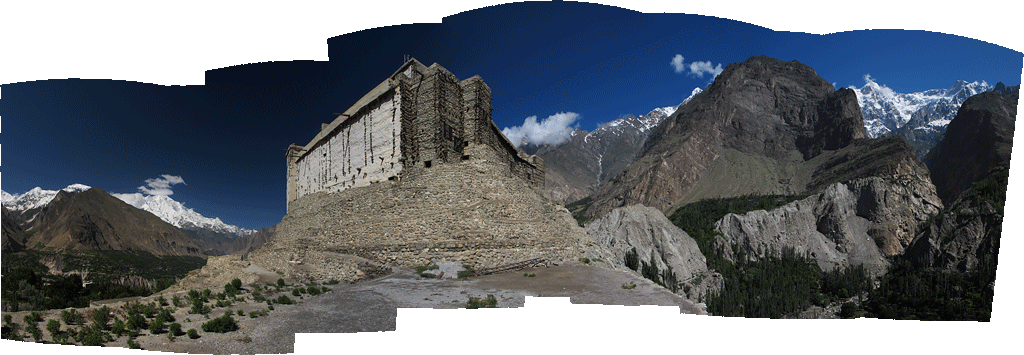
Panorama of Baltit fort (click to enlarge).
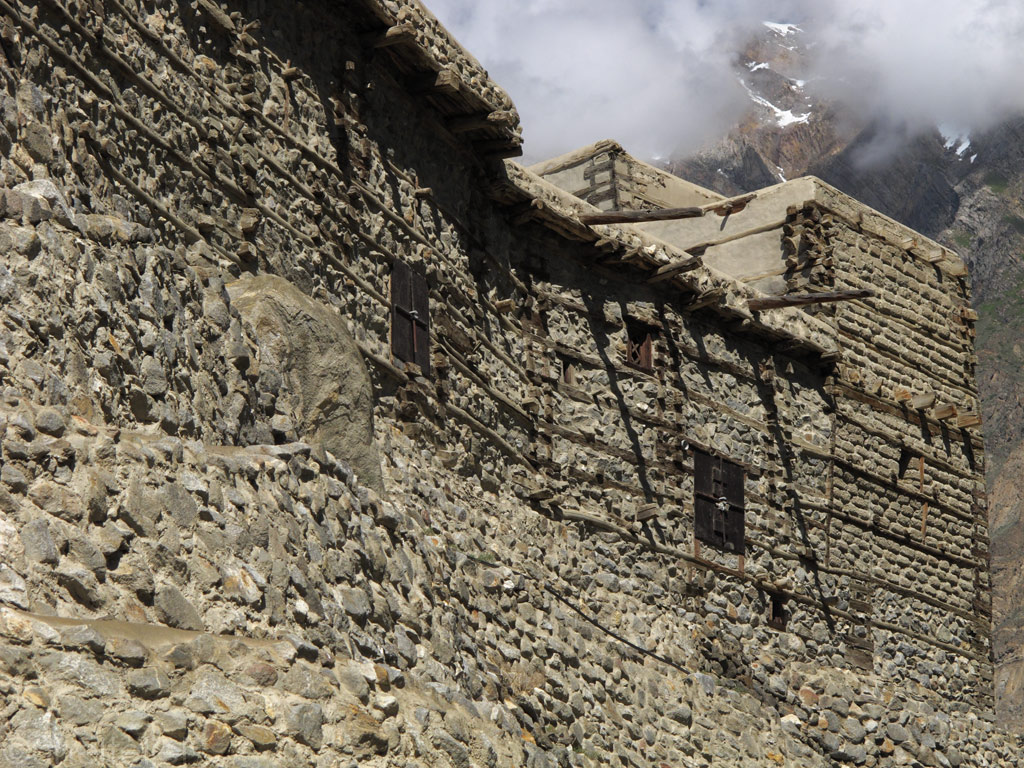
Fort is a combination of rock and wood - not just to stand the invasion, but also to stand the earthquakes - earth shakes in this region almost every 3 minutes!
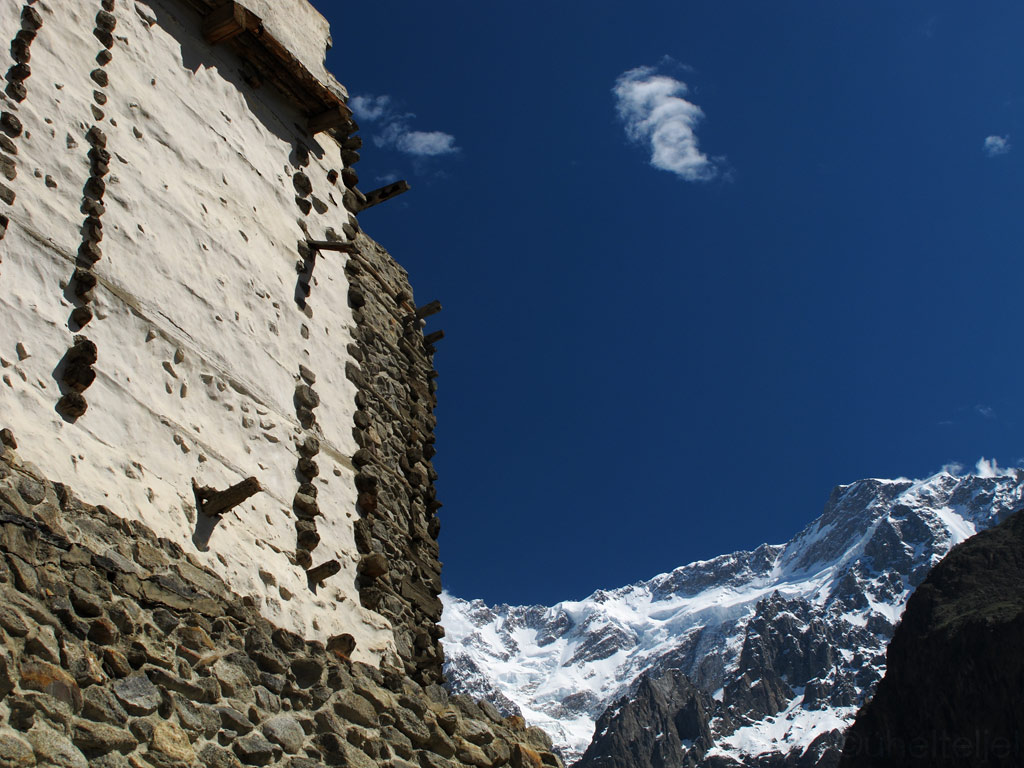
Rock and wood in their fusion - surrounded by bluish white peaks.
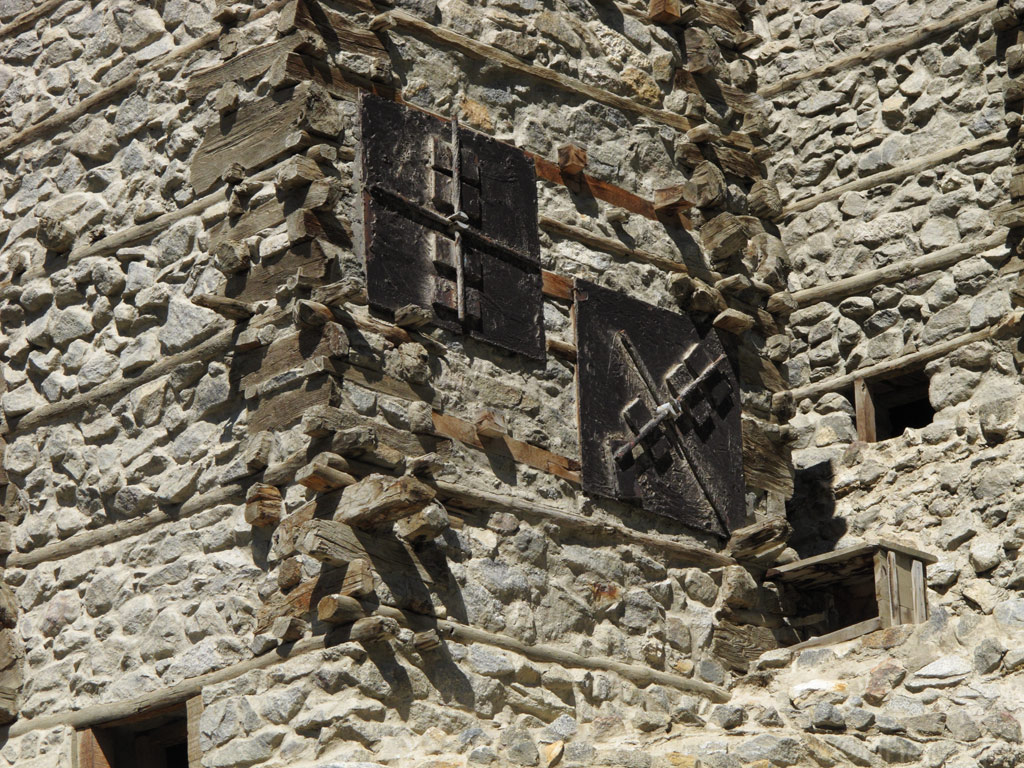
Windows or doors?
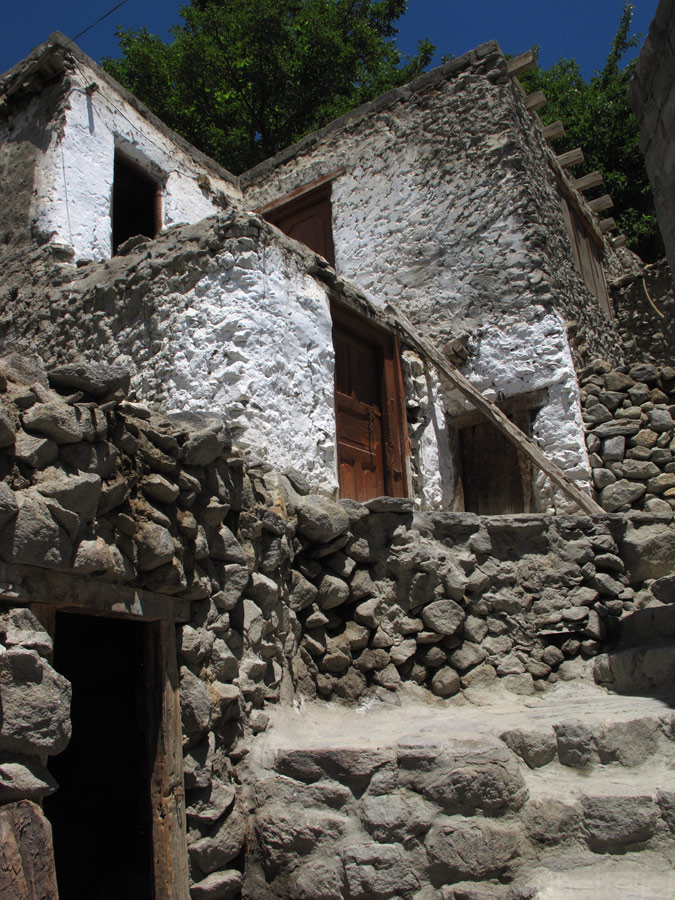
Typical village architecture in Karimabad.
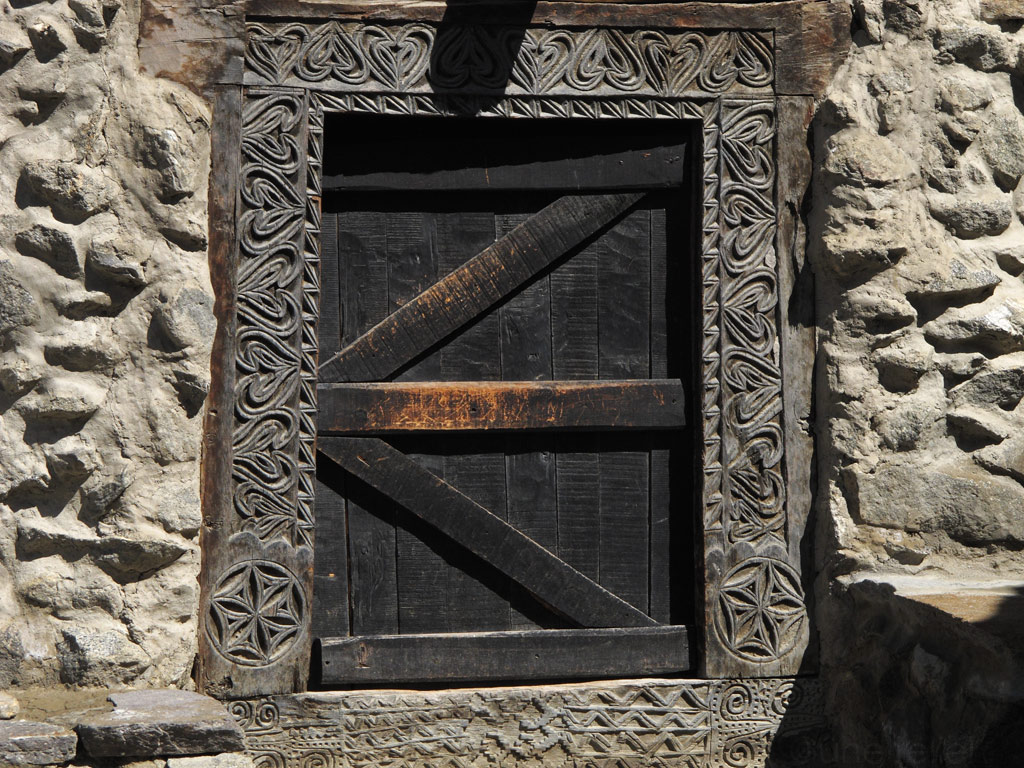
Artistic (and old!) wood carvings in a dwelling's doors.
Right behind the fort stands the mountain Ultar II. Not to become too relaxed, we decided to go for a walk into the canyon that leads to it. It was a true scramble and a strenuous walk uphill before we even reached the canyon, but once we were there we could really appreciate the vertical realm of it. There must have been a straight 100 metre drop from the track that had been blasted right into the rock wall, the meltwater torrent raging at the bottom.
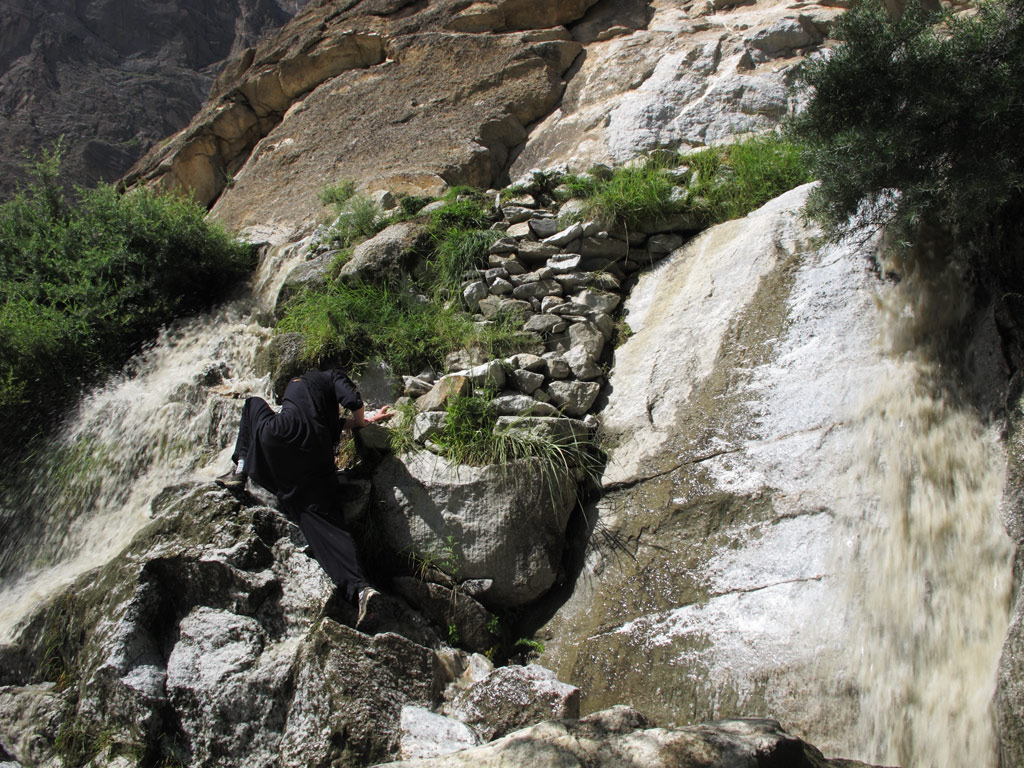
Kariina climbing up (like a special forces squad member in her muslim dress? )
)
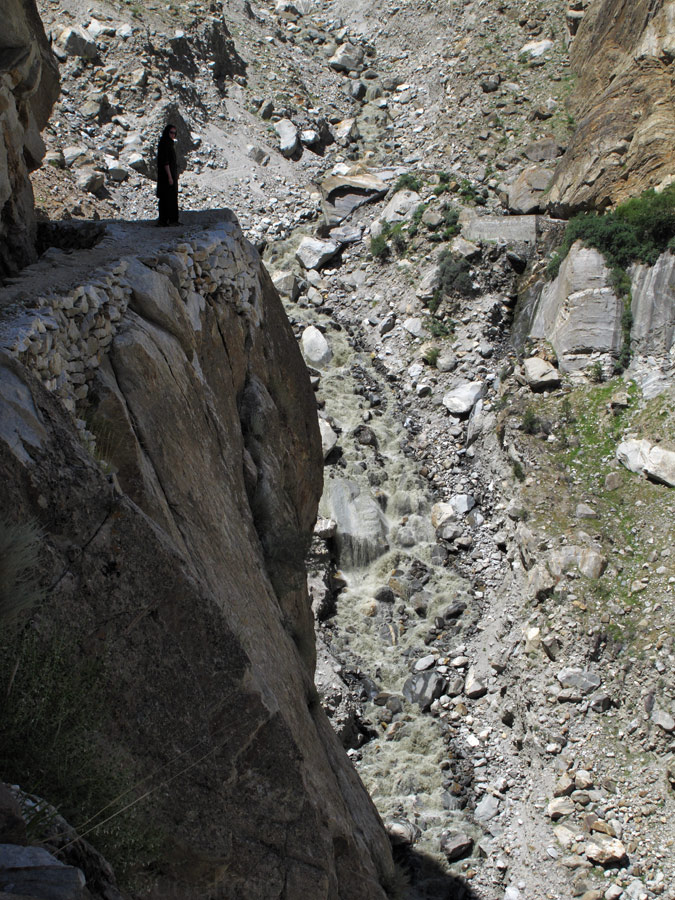
The path is carved into vertical canyon with explosives and supported by loose (!!!) rocks. Scary but also stunning to walk there with some 100+ meters of straight drop beneath your own feet.
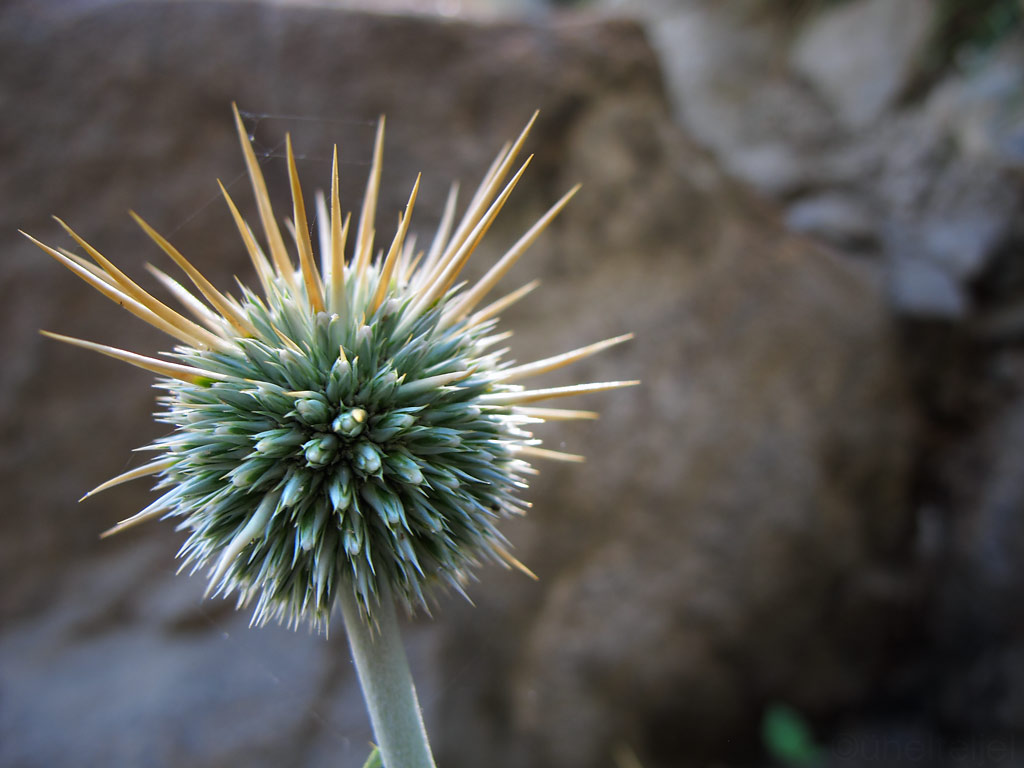
Local flora - is that where the toothpicks come from???

Panorama from the trail - see the depth from r/h side with the river and full grown trees below (click to enlarge).
When we got back to Karimabad we were exhausted, so we treated ourselves to a nice Hunza lunch. Hunza cuisine is pretty exemplary, with mostly local ingredients giving it the unique taste. Here are some examples.
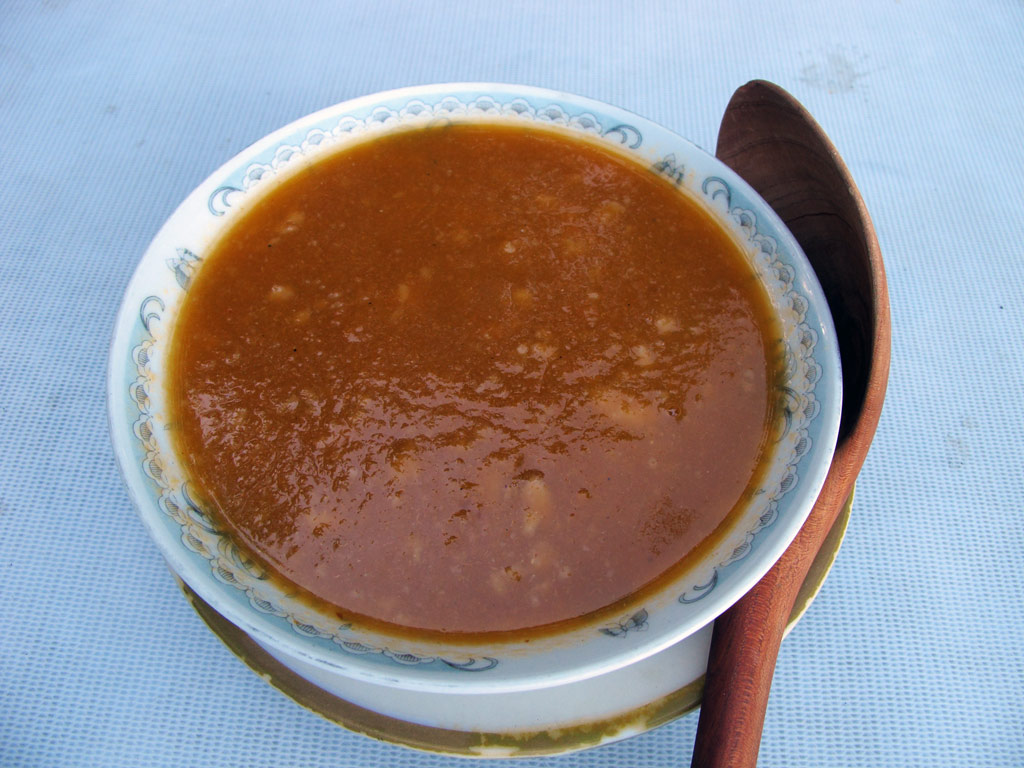
Apricot soup.
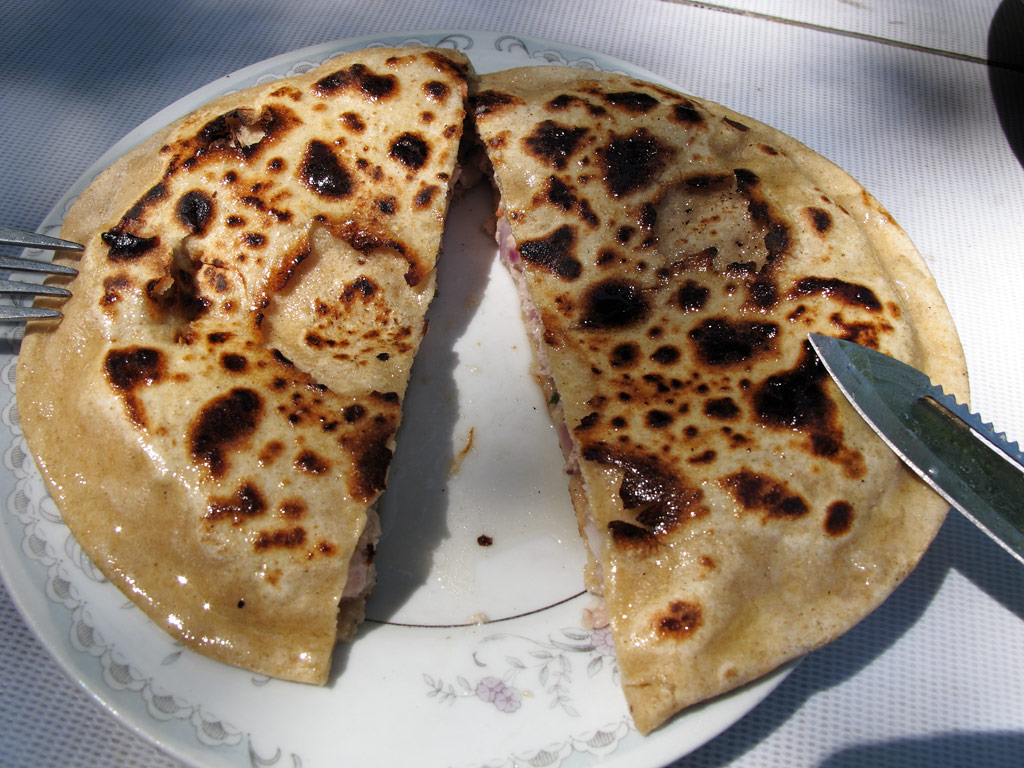
Chapsuro, also known as Hunza pizza, where filling is fried into chapatis.
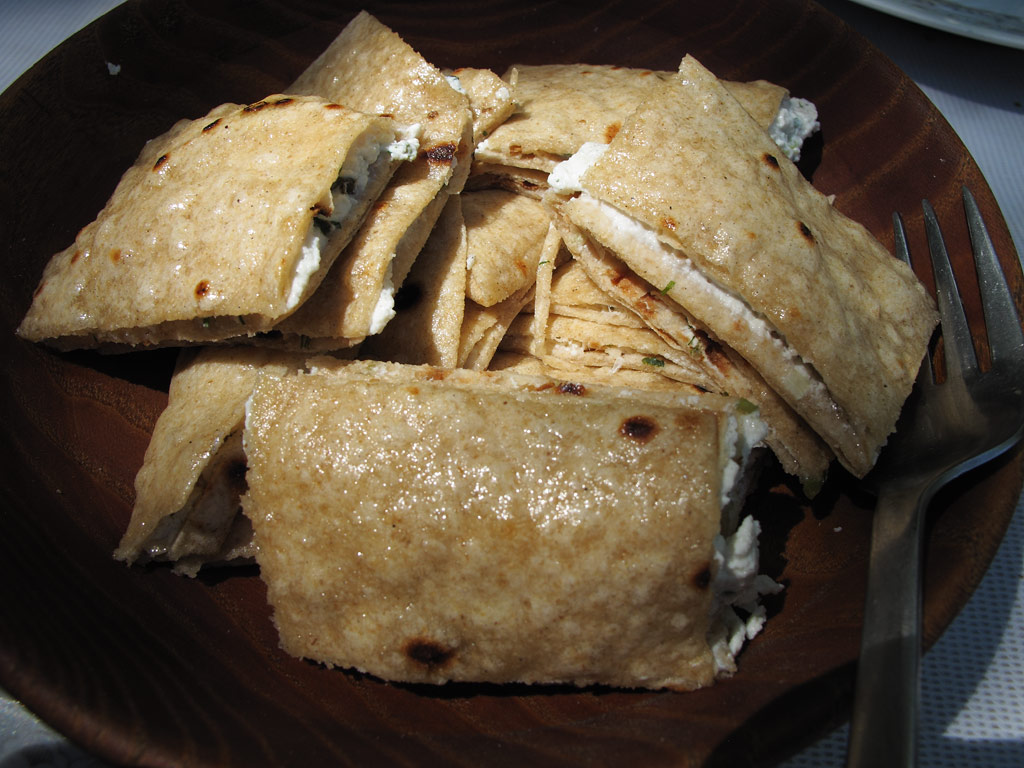
Burus berikutz - chapatis filled with local soft cheese (burus) mixed with mint and coriander. Apricot kernel oil on top of it gives it an extra aromatic punch.
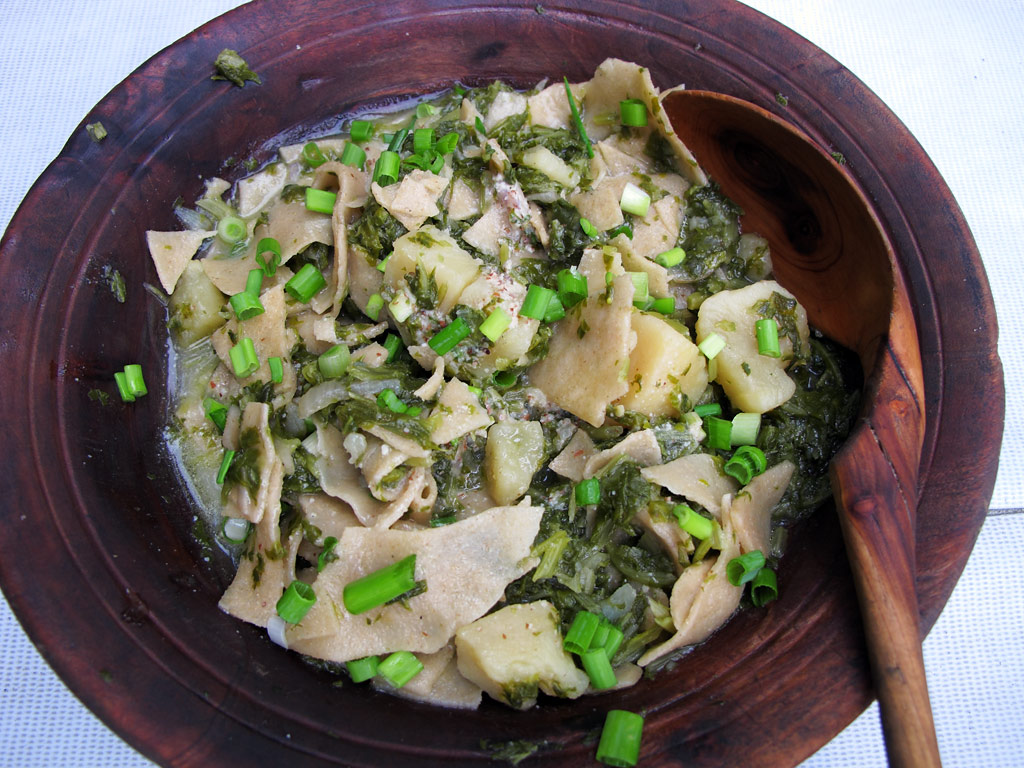
Hoilo garma or potatoes with spinach and chapati strips (reminded us of some home food).
While we were in Karimabad, a wedding was taking place with celebrations lasting several days. Here is a short video of some funky muslim dancing on the street - the band is playing live in the back of that small bus:
<object width="640" height="505"><param name="movie" value="http://www.youtube.com/v/DxtSH02ha9c&hl=en_US&fs=1"></param><param name="allowFullScreen" value="true"></param><param name="allowscriptaccess" value="always"></param><embed src="http://www.youtube.com/v/DxtSH02ha9c&hl=en_US&fs=1" type="application/x-shockwave-flash" allowscriptaccess="always" allowfullscreen="true" width="640" height="505"></embed></object>
And for those with specal interest in the sound of it, here's the better quality sound file:
Ride safe,
Margus & Kariina
There was a time when India and Pakistan were one country and there was only one Punjab, but from 1947 when Pakistan gained its independence from India, there are two - one Punjab in India, and one in Pakistan. In the latter, mosques now dominate the cityscape, as back when Pakistan separated people were given the opportunity to choose the country in which they wished to stay. A massive (and bloody) migration took place as many Hindus moved to the Indian side and many Muslims moved to the Pakistani side of the new border. One of the proposed name candidates for the new born country - today's Pakistan - was Islamistan.
Thus there is a great difference between the Indian and the Pakistani Punjab, at least when it comes down to interaction between people. In India or Nepal for example, I do not remember anyone expressing their impatience or anger, because in Hinduist and Buddhist cultures it is considered embarrassing even to raise your voice. What I remember is people being positive minded and (sometimes extremely) curious.
In Pakistan, however, the first impression was that of cheerlessness and indifference. And edginess. Which is strange, because so far we had thought of Muslims as of very warm and welcoming people. Maybe it is just the distrust towards the westerners? Or maybe it is just because we have arrived fresh out of a totally different mind set and the contrast is just too big? Or is it because we are simply over heated in this climate of over +40C (+104F)?
Even the A/C power socket in our hotel room could not take the pressure:

Thank God it didn't happen in the night and didn't burn down the hotel.
The people that work in the services sector are somewhat absent in anything they do, and the menus in the restaurant are only in Urdu which we fail to understand. It has been a long time since we last felt unwelcome in a strange country.

Menu in Urdu language.
In Lahore we were intending to go and have a look at Sufi (Islamic mysticism) rituals, but the meetings had been suspended as a couple of terrorists had blown themselves up at a Sufi meeting just a week ago, killing 42 and injuring 175 people! Had the Manali road been opened earlier, we just might have been one of those people.
Rather depressed, we went to try out a local dessert - falooda, which in Lahore comprises ice-cream and vermicelli. It looked nice when it was brought to table, but the waiter told us to mix it well, so that it became rather an interesting looking soup. I guess our desserts would look weird to Pakistanis, too. In any case it tasted good and we would definitely go for another if we find one.

Kariina and falooda.

Also worth mentioning on the culinary side - there is a chain in Rawalpindi, the sister city of Islamabad, that has the best ice cream milk shakes that we've ever tasted so far. Very recommended!

This small place in Rawalpindi serves the tastiest milk shakes!
Some more moments from our first days in Pakistan:

Colourful minibuses with 2-stroke single cylinder engines!

Pakistanis prepare their evening meals.

Melons for sale - bought one and they are tasty indeed!

Boy with a donkey.
By the way, the constuction of Islamabad only started in 1961, so it absolutely lacks any historic ambience. The blocks are numbered and the streets are straight, but the traffic is not flowing freely as there are barricaded police check posts stationed right in the middle of the road. It might look like a garden city, a civilised place to live, but it is not meant for people without their own means of transport. It has a kind of sterile feel to it.
There are not many tourist attractions in the capital of Pakistan. One of the very few is the Shah Faisal mosque, largely sponsored by king Faisal of Saudi Arabia. It was completed in 1986 and ity can hold up to 100 000 people. According to some rumours, the CIA asked to inspect its four 88-metre minarets suspecting that these might be missiles in disguise.

A muslim returning from prayers, beneath the Shah Faisal mosque.

Shah Faisal with its rocketing minarets. Mosque is modelled on a desert tent and can hold up to 100 000 muslims.

Mosque's top with its crescent.

Minaret in full length - see the man below to scale it up. No wonder CIA blamed them hiding ballistic missles in them.
From Islamabad we headed north to see the famous Karakoram Highway (KKH) - another wonder of the world, as the Pakistanis themselves think of it. Construction of this important link road between China and Pakistan began in 1959, and during 20 years that it took to be completed, almost 900 construction workers lost their lives due to falls and landslides. It spans some 1300 kilometers and is host to plenty of cultural heritage (it retraces parts of the ancient Silk Road) and views of some of the highest mountains of the world, such as 8126 metre (26 660 ft) high Nanga Parbat, for example.

Road sign in (a bit faulty) Russian - some Tadzhik trucks (used to) pass by KKH.
The start of the road from Abbottabad was pretty tense as there was loads of traffic. Interesting how Pakistan and India are so similar. Here, just like in India, the main rule in traffic is that anyone can make any manoeuvre at any time without any indication of such intention, and generally, "the might is the right". Once again, a minibus driver was attempting a right turn to the gas station across the road without looking, crashing into us from the left side. This time the impact caused the bike to fall over to the right side, and us to fall off the bike.
Lucky there was no one coming from the opposite direction, otherwise it would have ended quite sadly. As we stood up we could not detect much damage to ourselves except for some pain in my knee. But the bike is a different story. The left pannier was completely bent from the direct hit, the tank was once again dented and the windscreen altogether with the dashboard had been broken off from the right side due to the fall. A later inspection also revealed that both front and rear subframe were bent.
In just a couple of minutes a crowd gathered. Sure, nobody spoke any English, all the less the guy to blame who just stood there blank faced as Kariina was leading her monologue on her feelings towards him and Pakistani drivers in general. She might have spoken in Estonian instead of English, it would not have provoked any reaction.


Gathering crowds - find the muslim with glasses that tries to hide from the photo - that's the selfish twat who almost killed us!
With the help from a local student we found a workshop where the pannier was hammered into a more or less regular shape. Clearly it is just a temporary solution as the lid only closes more or less, and there are some holes in it that need the hard-to-find aluminium welding - the only place they say is in Rawalpindi (like in India - amazingly ironic for a country that has nuclear capability!?). To put it simply, the pannier now is far from being waterproof.

Left box took the direct hit this time (while from that force we flipped over and landed on to the other side, the other box had just scratches)


Tank, after bike landing on it.

Windscreen - good thing it's already riveted with aluminium plate from the last crash in Australia.

But the mount is still ripped off from the impact and also front frame is bent.

Using robust Pakistani villager's methods to make primary repairs.
Exhausted, and soaked in sweat, we checked into the first hotel we could find. It was an expensive one, but there was no energy nor motivation left to go looking for alternatives.
Frustrated, we spent the night trying to understand what we had done wrong to deserve such a reception. Or, on the contrary, had there been someone looking after us, a guardian angel perhaps? Trying to think positively, it was a lucky accident afterall.

My busted leg.
Next day we rolled on. The traffic dissipated a bit, but the road deteriorated, too. Where the road traversed the areas of Indus Kohistan kids threw rocks at us, and we had an exceptionally shocking moment as we almost ran over a girl running across the road. She just ran onto the road from behind a parked car, and no braking would not have saved her if she would have noticed us coming. No doubt she would have been petrified right in the middle of our track. But the guardian angels (hers, not ours - our credit must have already expired) must have been on the watch as she just kept on running, without looking, so we passed her with an inch or so. Would it have been a car, the ending would have been different. Worst of all, when we looked back at the parents standing aside the road, they did not look shocked at all, just as if it were normal for their kids to have such close calls.
Welcome to Pakistan indeed!
The further north we moved along the Karakoram Highway, the more relaxed the people became though. When we stopped at some village to buy a bottle of water, the faces in the crowd that surrounded us were speaking a different language. Sure there was some distrust towards us as foreigners - some preferred not to join the crowd but to observe us from the distance, but there was a sense of positivity and curiosity, too, that we had not felt in the areas further south. In any case, being surrounded by men wearing the funky pancake hats we did not feel unfomfortable or unsafe. Maybe it is the following scene that gave us more confidence. Just as I took out the camera, an old guy with a crumpled nose insisted I take a picture of him. Others started laughing, obviously pointing out that he did not quite fit the parameters of a photo model. He laughed, too, and there were no hard feelings. It is nice when people do not take themselves too seriously.

Typical Pakistanis on wheels.

A funky old man.

Pakistani Muslims in their "pancake" hats.



One of the mullah's inspecting us in Chilas.

A decent beard is a Muslim man's pride.

Rolling on, we soon started to realise what we had come here for. The ninth highest mountain in the world, Nanga Parbat, was standing before us (well, actually behind us - hadn't I looked in the mirror we would have had missed it!). Standing 8126 meters (26 660 ft) high, it is the westernmost 8000+ mountain in the world.

Nanga Parbat - stunning 26 660 ft!
But there are other, lower but still attractive peaks as well, many of which can be contemplated from Karimabad, the capital of the ancient kingdom of Hunza, even without any major hiking. For example Rakaposhi (7788 meters), Ultar II (7388 meters), Diran (7270 meters), Hunza Peak (6270 meters), Bubulimating (6000 meters), Altit Peak (5075 meters).

Mountains seen from Gilgit.

A white cold top surrounded by warmer lower mountains in the last sunlight.

Panorama from Gilgit (click to enlarge).

A white top in Karakoram.

Rakaposhi (25 550 ft)

The sharp peak on the left is called Lady Finger (Bubulimating in local language), sided by Hunza peak.

The mighty Rakaposhi from another angle and lit up by the last sunrays.

Altit Peak.

Panorama of the Ultar II (24 200 ft) - click to enlarge.

Panorama of Rakaposhi (click to enlarge).

Panorama from different peaks seen from Duikar (click to enlarge).

A looong panorama from Eagle's Nest viewpoint in Duikar - a decent view of the Karakoram's might (click to enlarge).
Hunza is roughly the region where the Asian and Indian plates collided millions of years ago. The process of terraforming is far from being over, though, as the Indian continent still keeps on moving north. Thus it is only logical that the earth trembles here some every three minutes or so. This, of course, leads to landslides.
One major landslide took place here in January this year, blocking Hunza river and subsequently creating a lake that is by now some 100 meters deep and kilometers long. The problem is, that a part of the Karakoram Highway, the only connection road to the Chinese border now lay submerged together with some villages. Unable to clear the rubble that is damming the river, the locals have introduced boat transport across the lake.

Hunza lake - created by a gigantic landslide and has drowned KKH road along with number of villages.

4x4 is a preferred way of transport on KKH.

Panorama from the Hunza lake (atop of the landslide itself) - click to enlarge.
Hunza was indeed the most pleasant region we had visited so far in Pakistan. Not only has it the views, but the people are different here. Maybe it is the cooler mountain air, or maybe it is because the people here follow a different branch of Islam, namely Ismailism. One of the first things to notice here is the presence of colourfully dressed (no burkas!) women in the streets, but the overall attitude of the locals is much more positive and relaxed than elsewhere.

Panorama from the road (click to enlarge).

A brick factory aside the Karakoram Highway.

Road from Hopar - Ultar II glowing in front of us.

Apricots in Hunza valley are world famous, fed by Karakoram's rich minerals and baked in high altitude sunlight - they taste good indeed!

Ismaili muslims in Hunza are friendly and welcoming.

Young girl at work.

800 years old Altit fort on the backdrop of the Hunza Peak.

Panorama of the Altit fort.

2000 year-old rock inscriptions in Hunza valley. Mostly reflecting hunting-scenes.


And, last but not least, we found a 10-rupee note in a bag of potato chips.
Soon enough we realised that the words of the guest house owner in Karimabad were true - Hunza indeed had some sort of magnet that did not want to let go of us. We had thought of spending there a couple of days, but ended up staying a whole week.
It was a relaxing time. The mountain views, good food and pleasant atmosphere all contributed to recharging of our batteries and harmonizing of our brain waves. Positive thoughts towards the future returned to us. It was a total zen, if you like.
The weather, actually, was nothing too special. Hunza is a relatively dry place, so that even during the monsoon season there is not much rainfall. Maybe it is due to the climate change that while we were there it rained two days in a row so that we could barely get out of our room. When the rain stopped, however, the receding clouds and the mingling light showed us the mountains at their most spectacular.

Light play...


A white 25 000+ft top almost revealing itself...

Ultar II, clouds above and below it.


Panorama of Hunza valley's steep rocky sides (click to enlarge).

The view...

Panorama from Ultar canyon (click to enlarge)
Since there is not much precipitation, all life in Hunza depends on the glaciers and the meltwater. Without there would not be much more than rocks and sand. But as long as the glaciers are there (and there are loads of them in the area!), the friendly folk of Hunza may continue telling stories of their ancient kingdom while drying apricots on their roof tops. The apricots of Hunza are famous all over Asia, as well as the walnuts grown there.

Hunza ismaili-muslim playing a traditional instrument in Karimabad.

Apricots drying on the house roofs.

And walnuts are still ripening...
A long time ago, there were actually many kingdoms in this area. When Marco Polo visited in the 13th century, he said the place was "noisy with kingdoms". The kingdom of Hunza is however one of those few that have left a tangible heritage - both physical and cultural which is still visible today. It is interesting to point out that officially Hunza only adhered to Pakistan and the status of its ruler was decreased to a district official in 1974. The locals, however, are still fond of the old times and their ruler, and do not really think of themselves as of Pakistanis.
One of the more prominent reminders of the glorius past is the 13th century fort overlooking the village of Karimabad. It has played host to many a ruler, and the last one to live there only moved out to more modern quarters in 1945. The fort has seen many additions and modifications since it was originally constructed. In the 17th century for example, the ruler married a daughter of the king of Baltistan, who brought a bunch of masons as a dowry. This resulted in many Tibetan style additions to the fort, and this is probably why it is now called the Baltit fort.

Baltit fort in Hunza valley.

Wall of the fort.

Panorama of Baltit fort (click to enlarge).

Fort is a combination of rock and wood - not just to stand the invasion, but also to stand the earthquakes - earth shakes in this region almost every 3 minutes!

Rock and wood in their fusion - surrounded by bluish white peaks.

Windows or doors?

Typical village architecture in Karimabad.

Artistic (and old!) wood carvings in a dwelling's doors.
Right behind the fort stands the mountain Ultar II. Not to become too relaxed, we decided to go for a walk into the canyon that leads to it. It was a true scramble and a strenuous walk uphill before we even reached the canyon, but once we were there we could really appreciate the vertical realm of it. There must have been a straight 100 metre drop from the track that had been blasted right into the rock wall, the meltwater torrent raging at the bottom.

Kariina climbing up (like a special forces squad member in her muslim dress?
 )
)
The path is carved into vertical canyon with explosives and supported by loose (!!!) rocks. Scary but also stunning to walk there with some 100+ meters of straight drop beneath your own feet.

Local flora - is that where the toothpicks come from???

Panorama from the trail - see the depth from r/h side with the river and full grown trees below (click to enlarge).
When we got back to Karimabad we were exhausted, so we treated ourselves to a nice Hunza lunch. Hunza cuisine is pretty exemplary, with mostly local ingredients giving it the unique taste. Here are some examples.

Apricot soup.

Chapsuro, also known as Hunza pizza, where filling is fried into chapatis.

Burus berikutz - chapatis filled with local soft cheese (burus) mixed with mint and coriander. Apricot kernel oil on top of it gives it an extra aromatic punch.

Hoilo garma or potatoes with spinach and chapati strips (reminded us of some home food).
While we were in Karimabad, a wedding was taking place with celebrations lasting several days. Here is a short video of some funky muslim dancing on the street - the band is playing live in the back of that small bus:
<object width="640" height="505"><param name="movie" value="http://www.youtube.com/v/DxtSH02ha9c&hl=en_US&fs=1"></param><param name="allowFullScreen" value="true"></param><param name="allowscriptaccess" value="always"></param><embed src="http://www.youtube.com/v/DxtSH02ha9c&hl=en_US&fs=1" type="application/x-shockwave-flash" allowscriptaccess="always" allowfullscreen="true" width="640" height="505"></embed></object>
And for those with specal interest in the sound of it, here's the better quality sound file:
Ride safe,
Margus & Kariina






